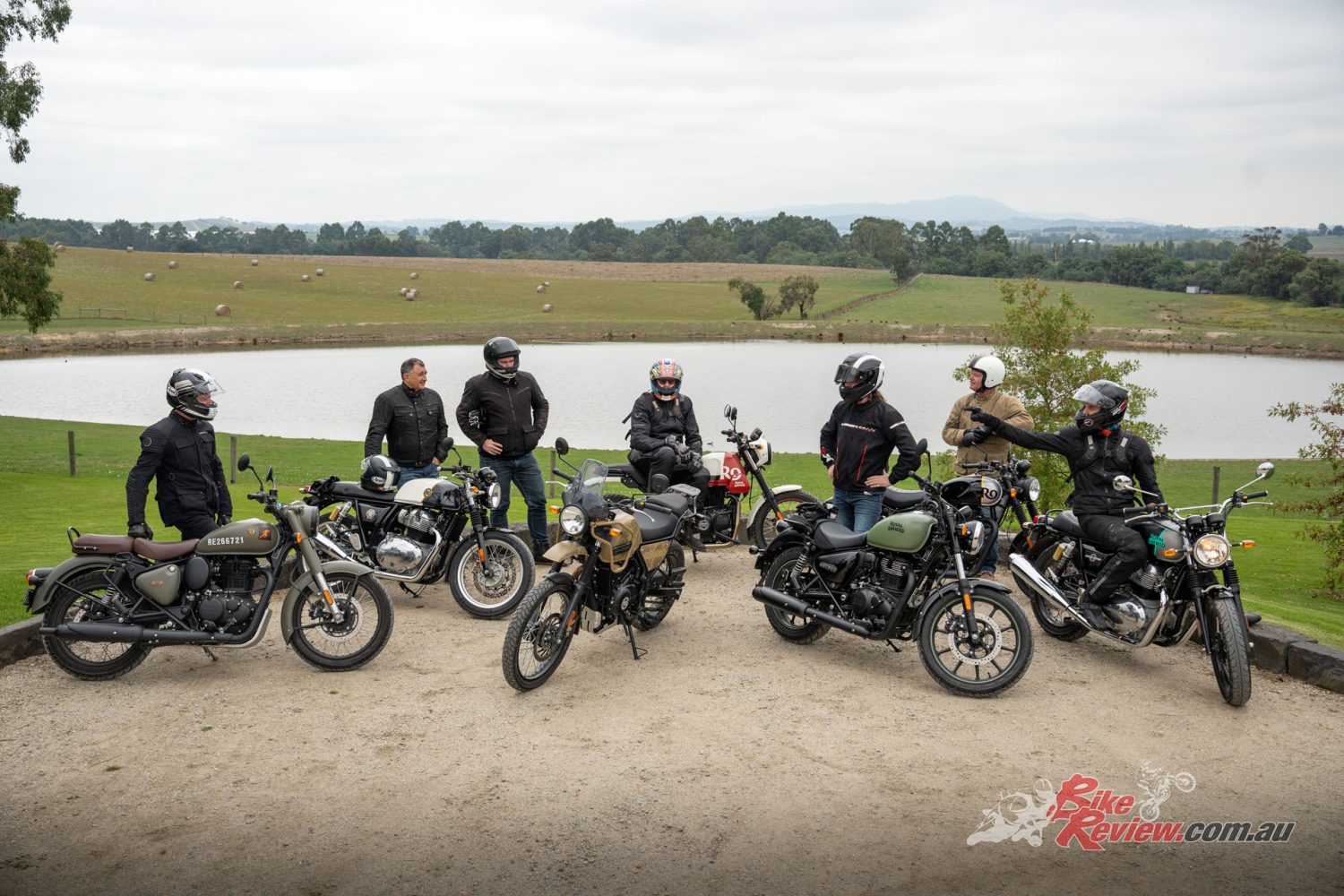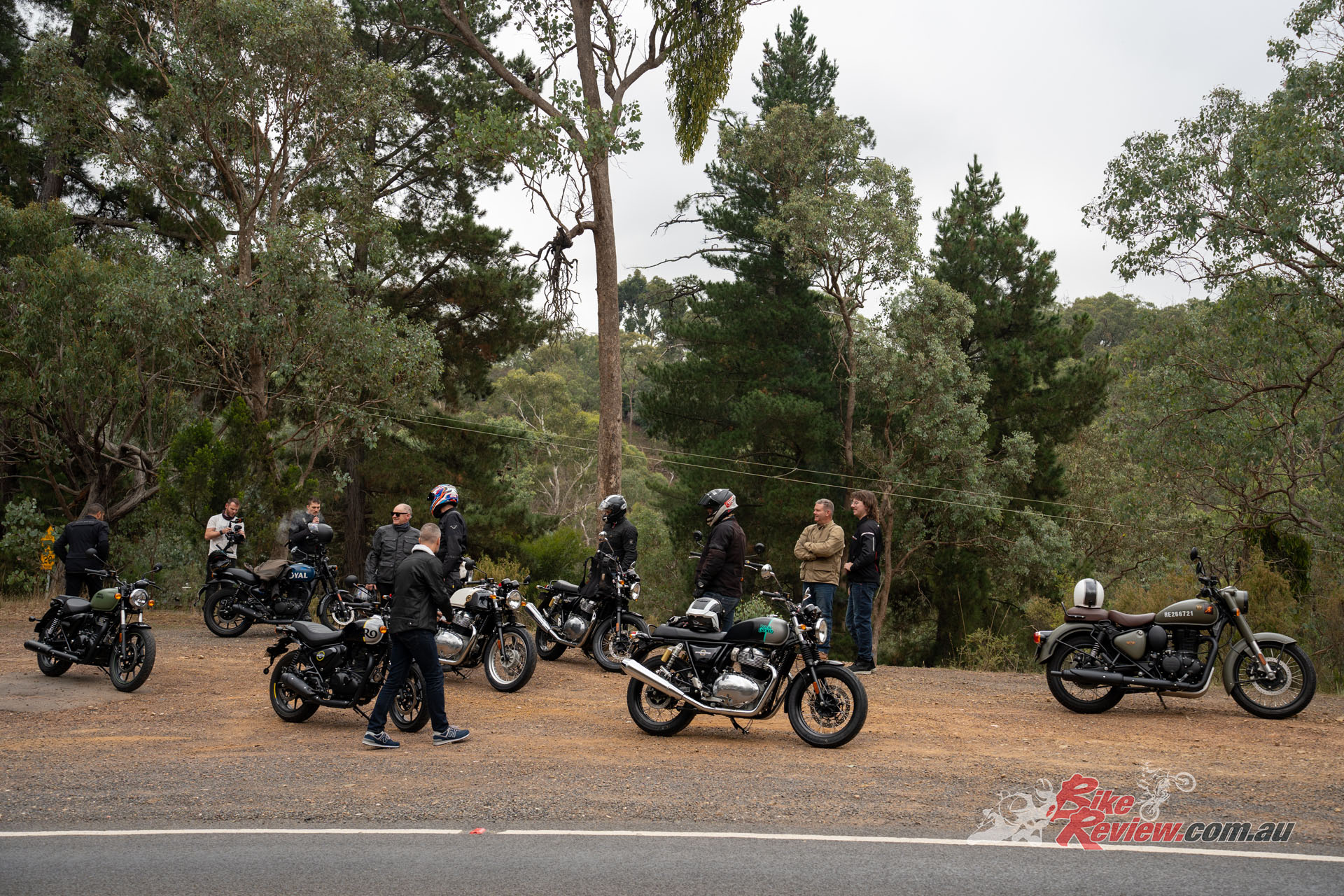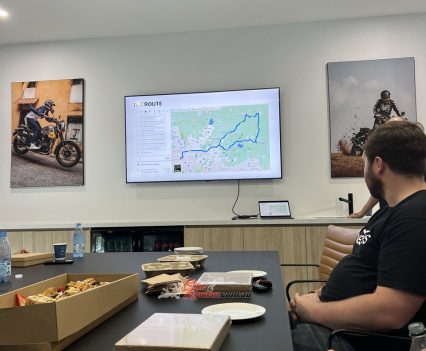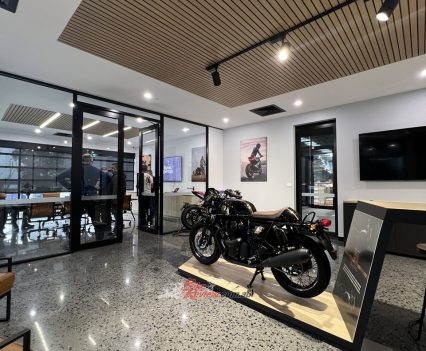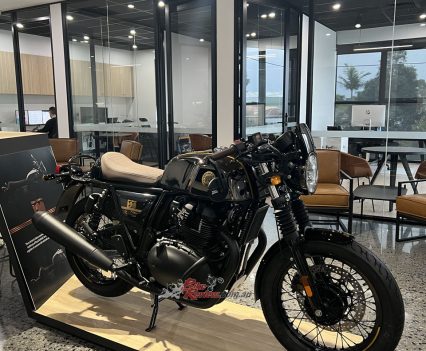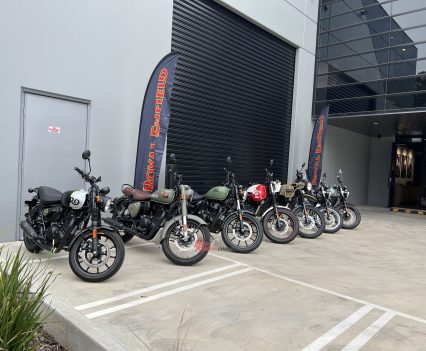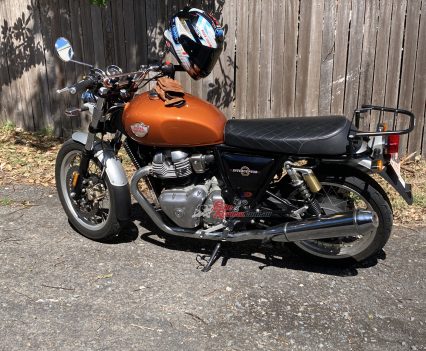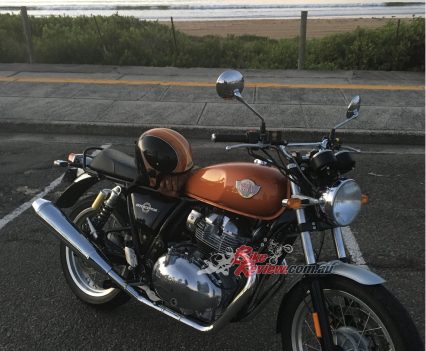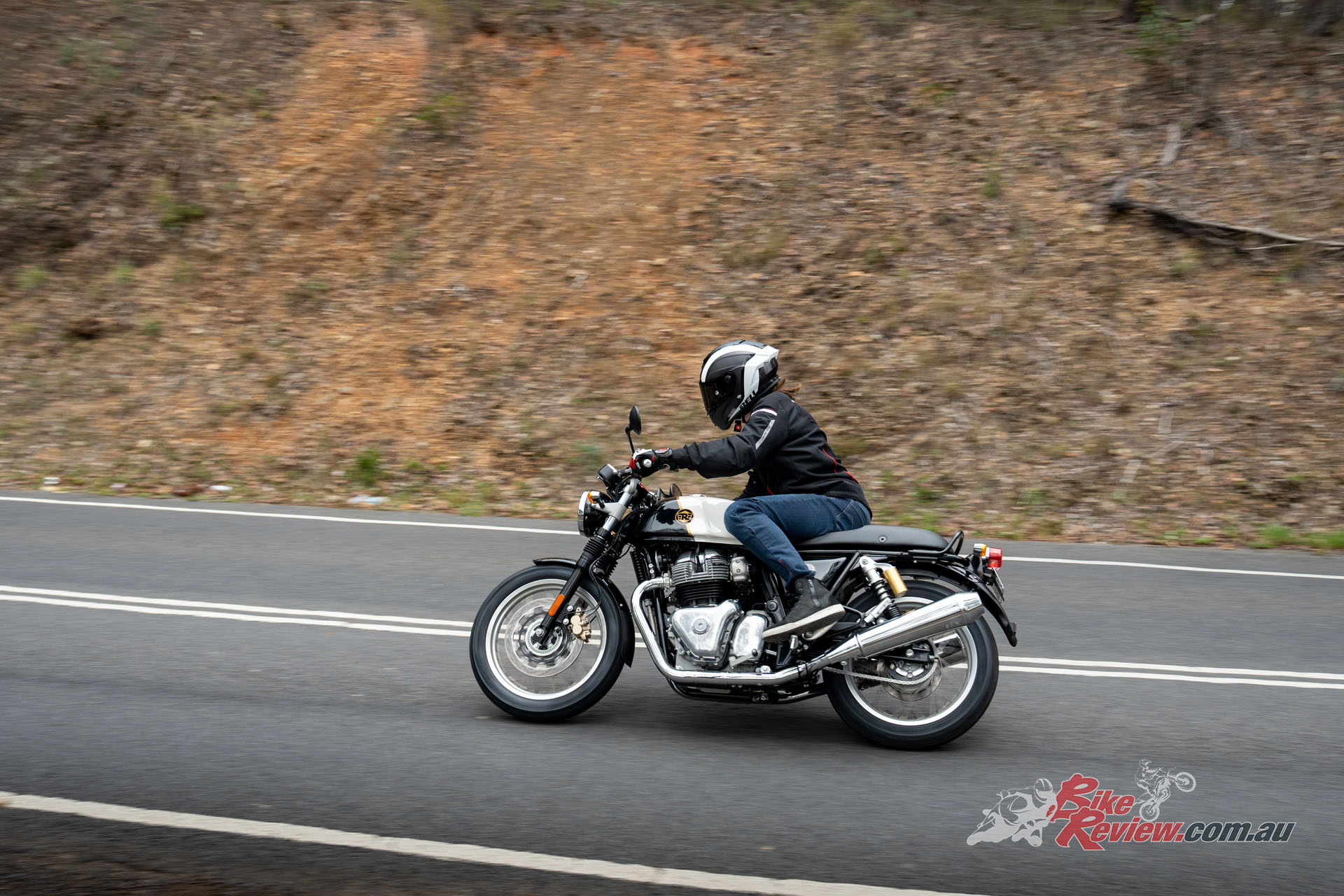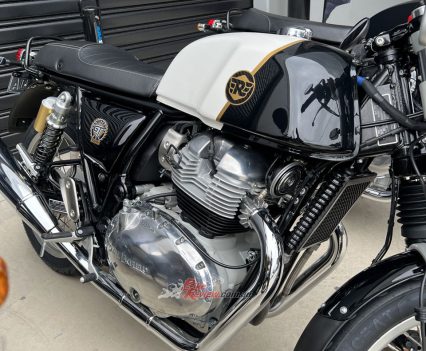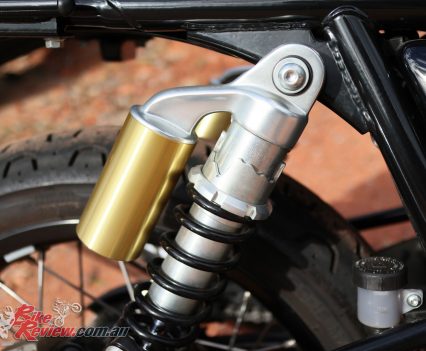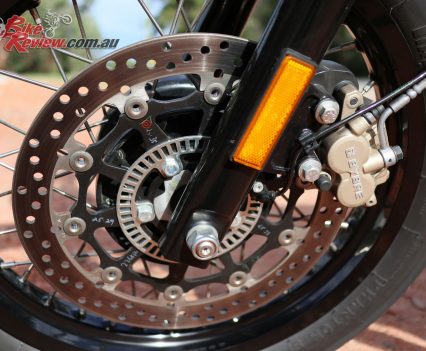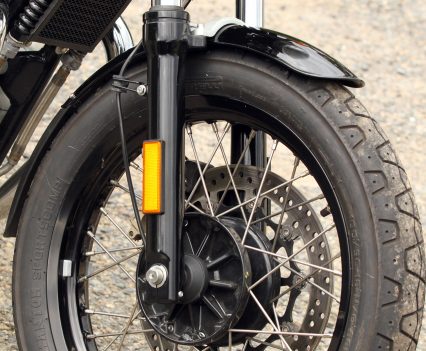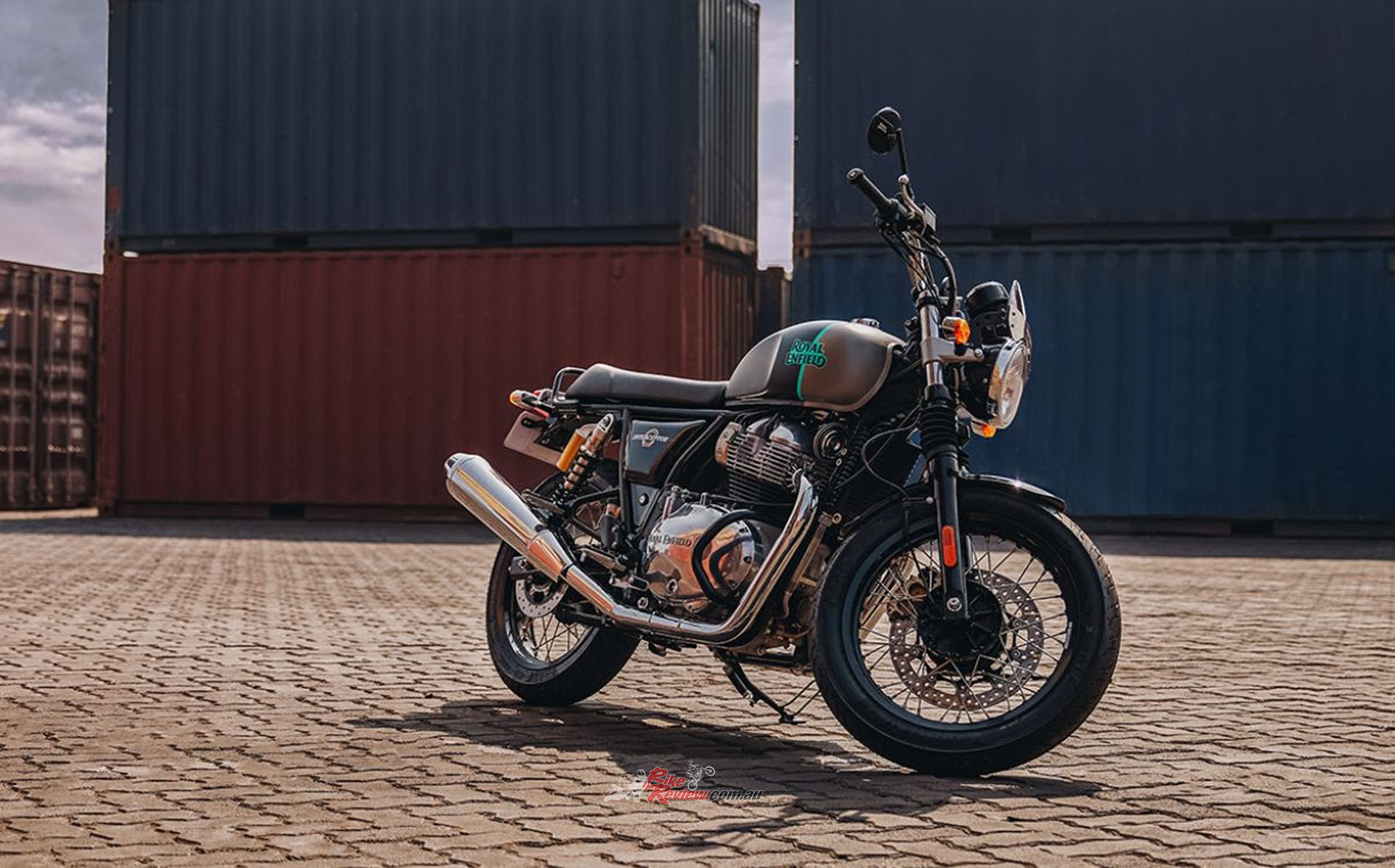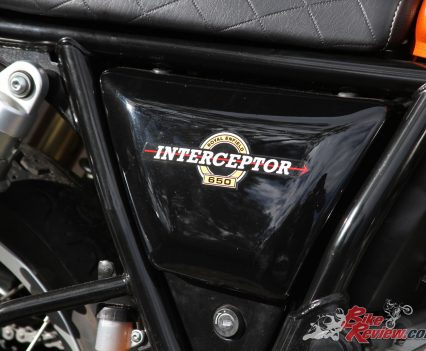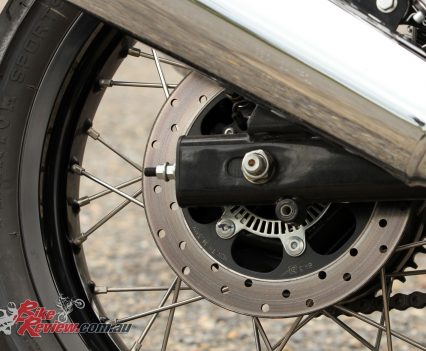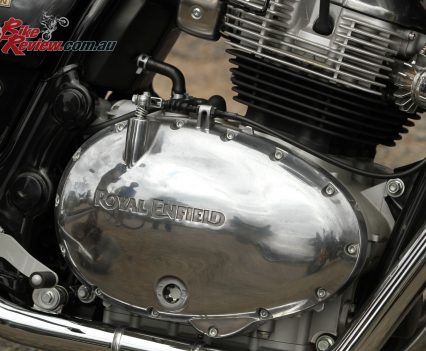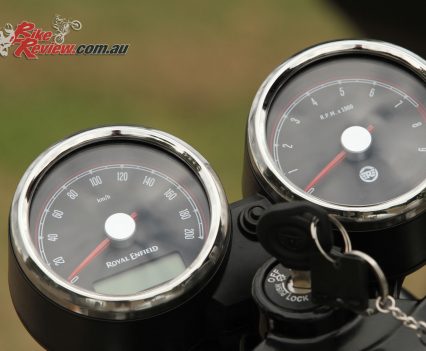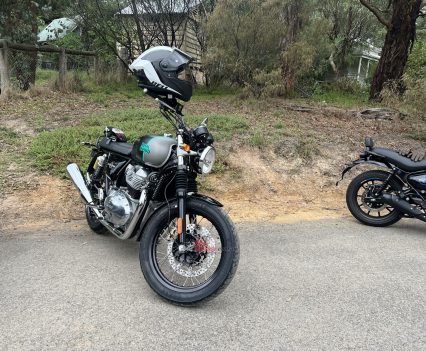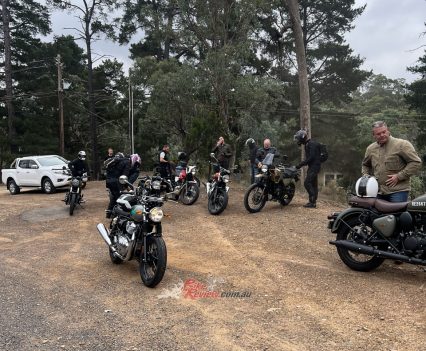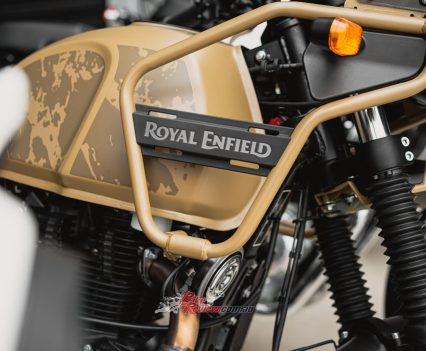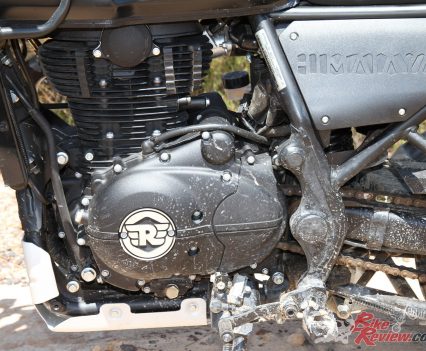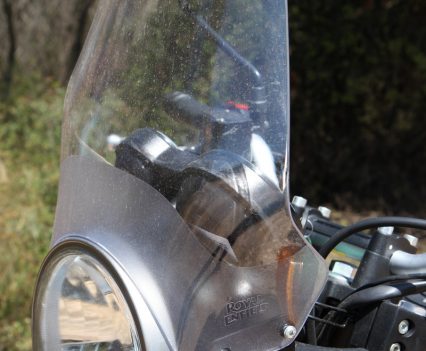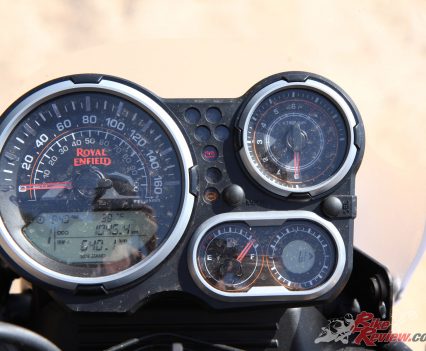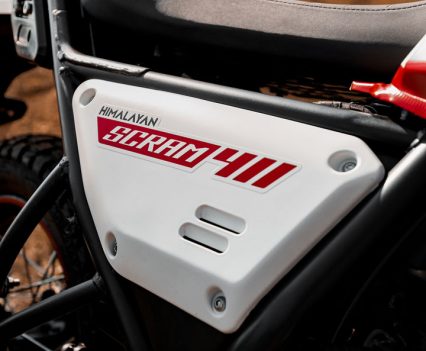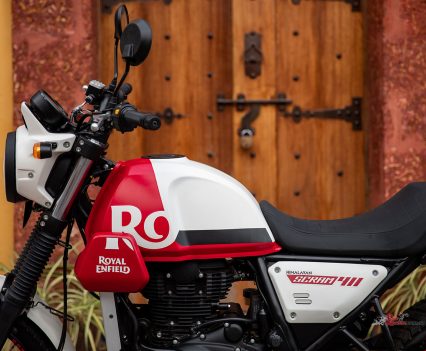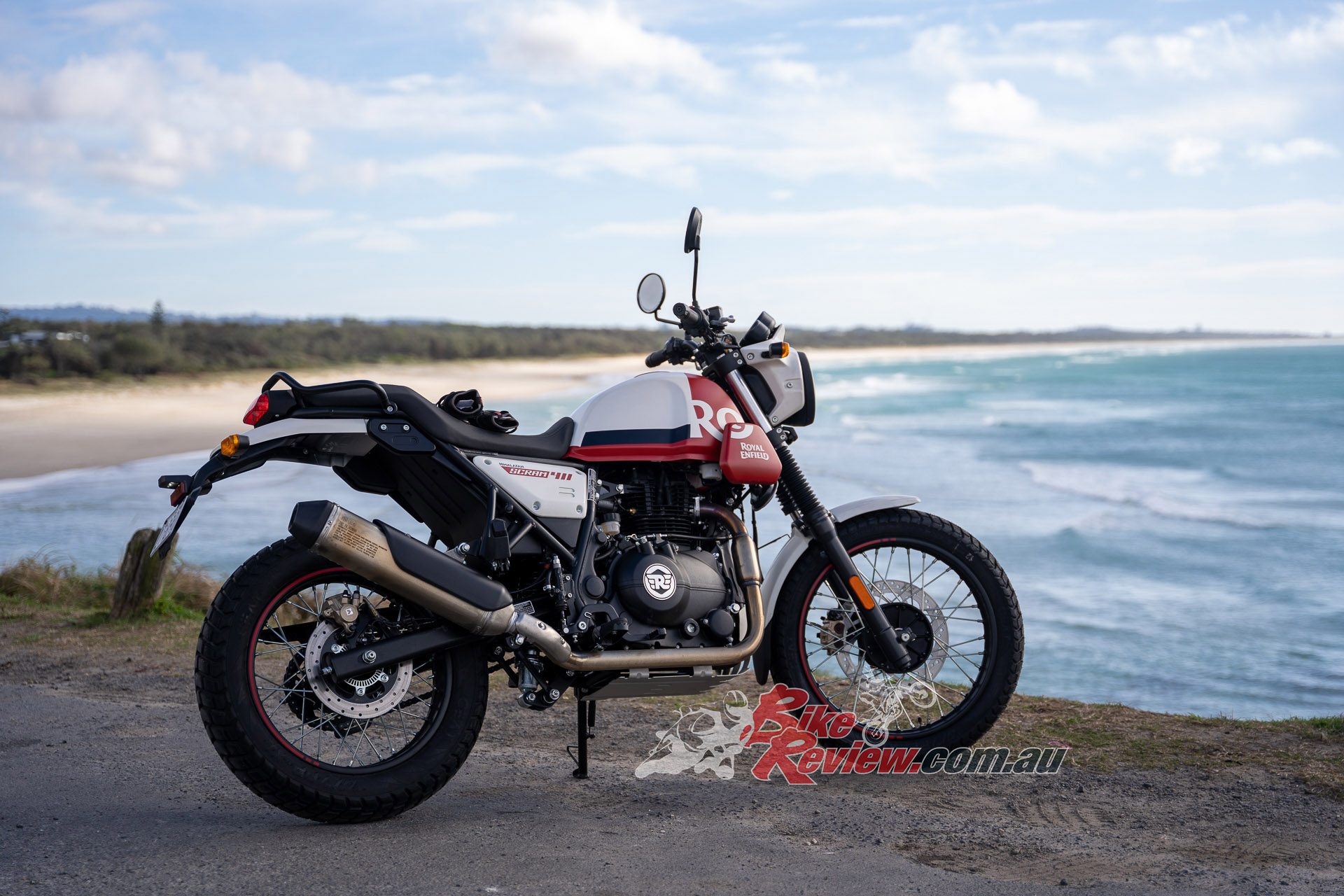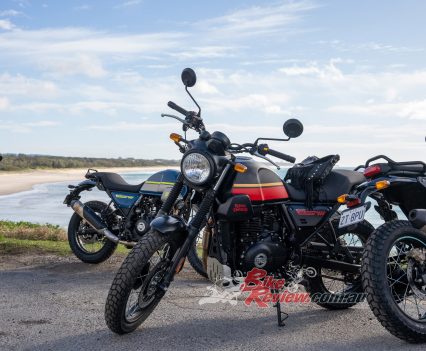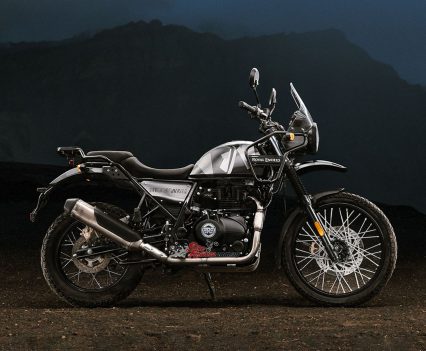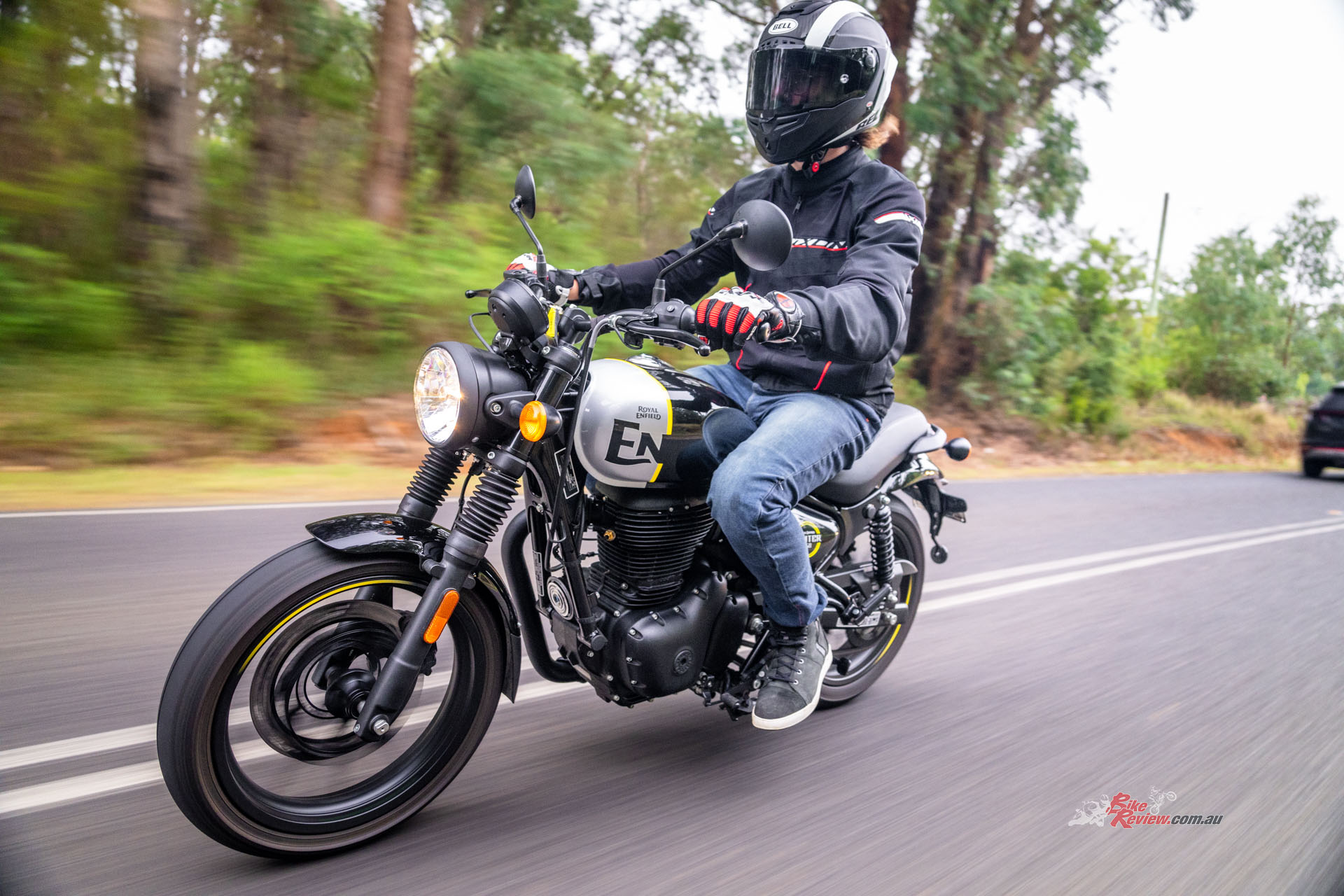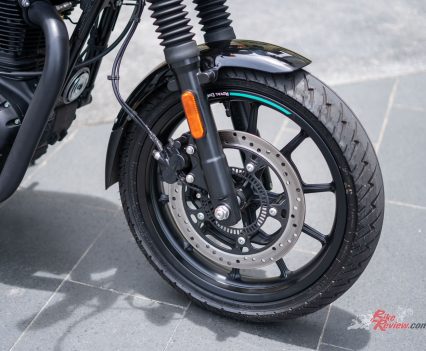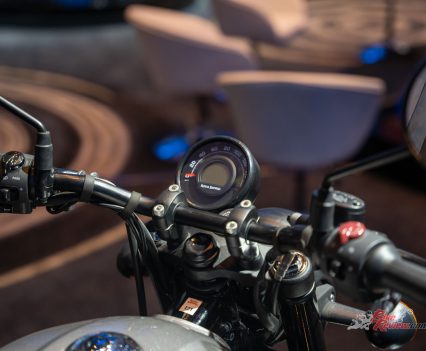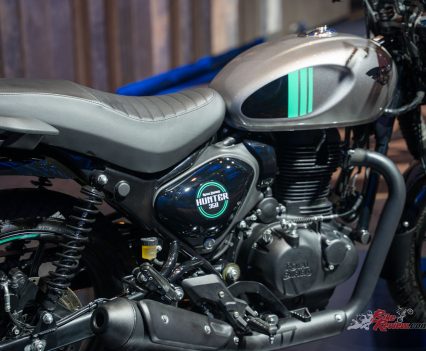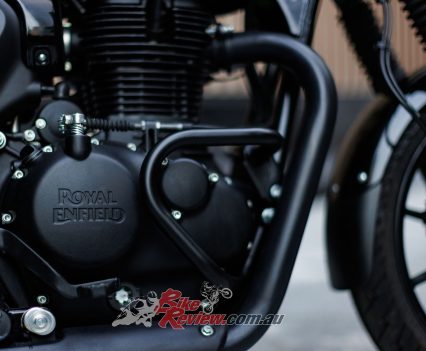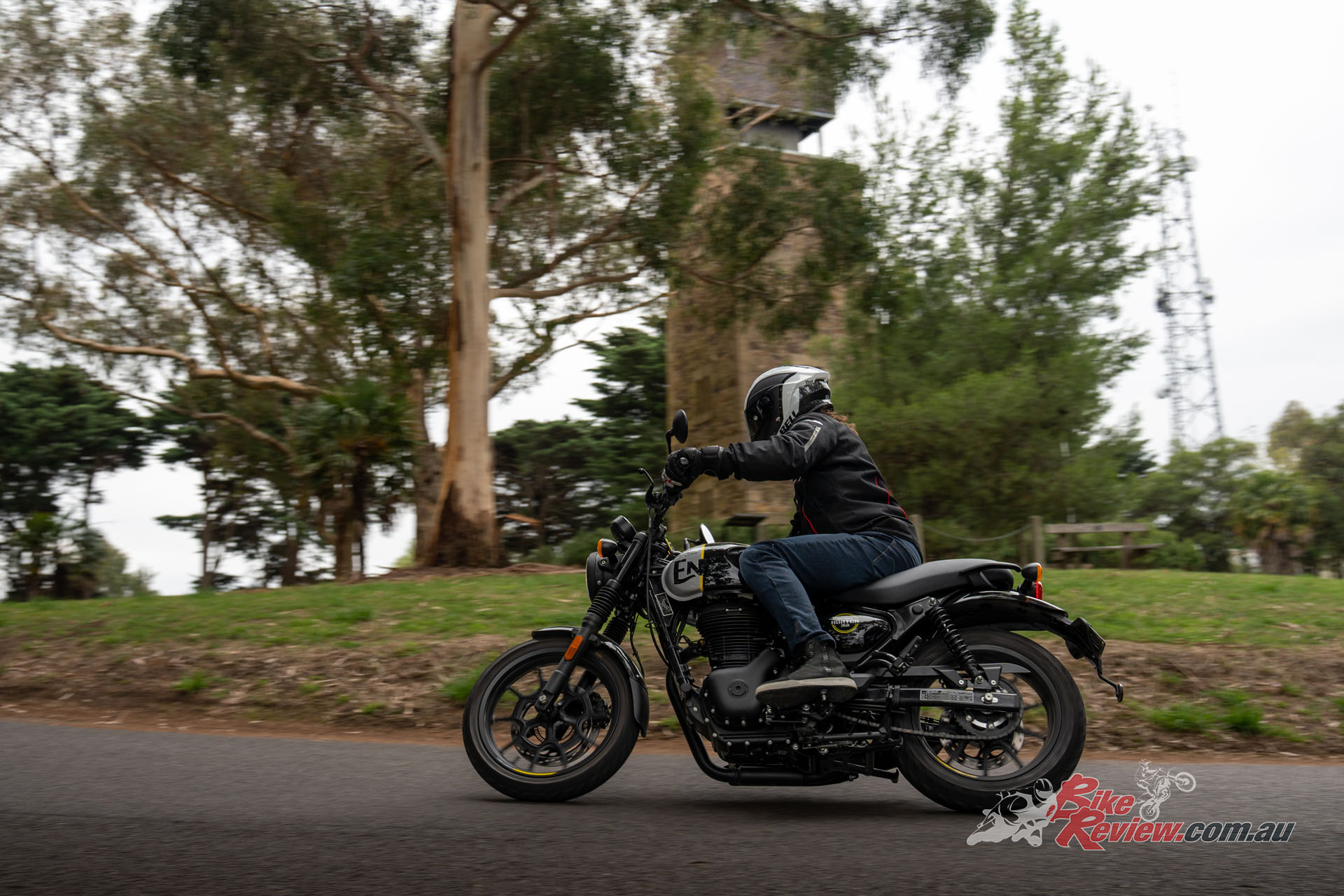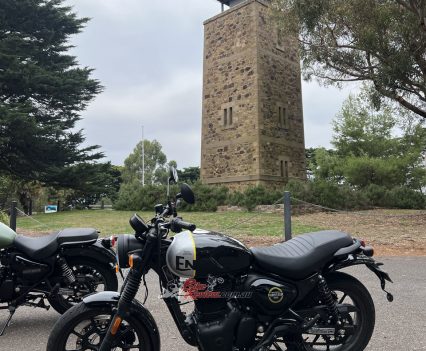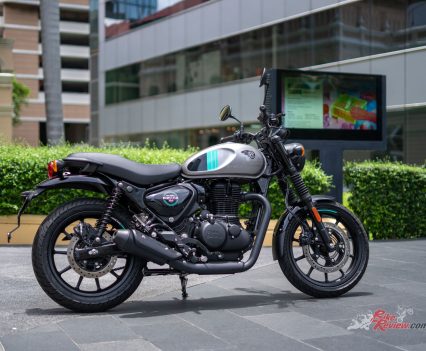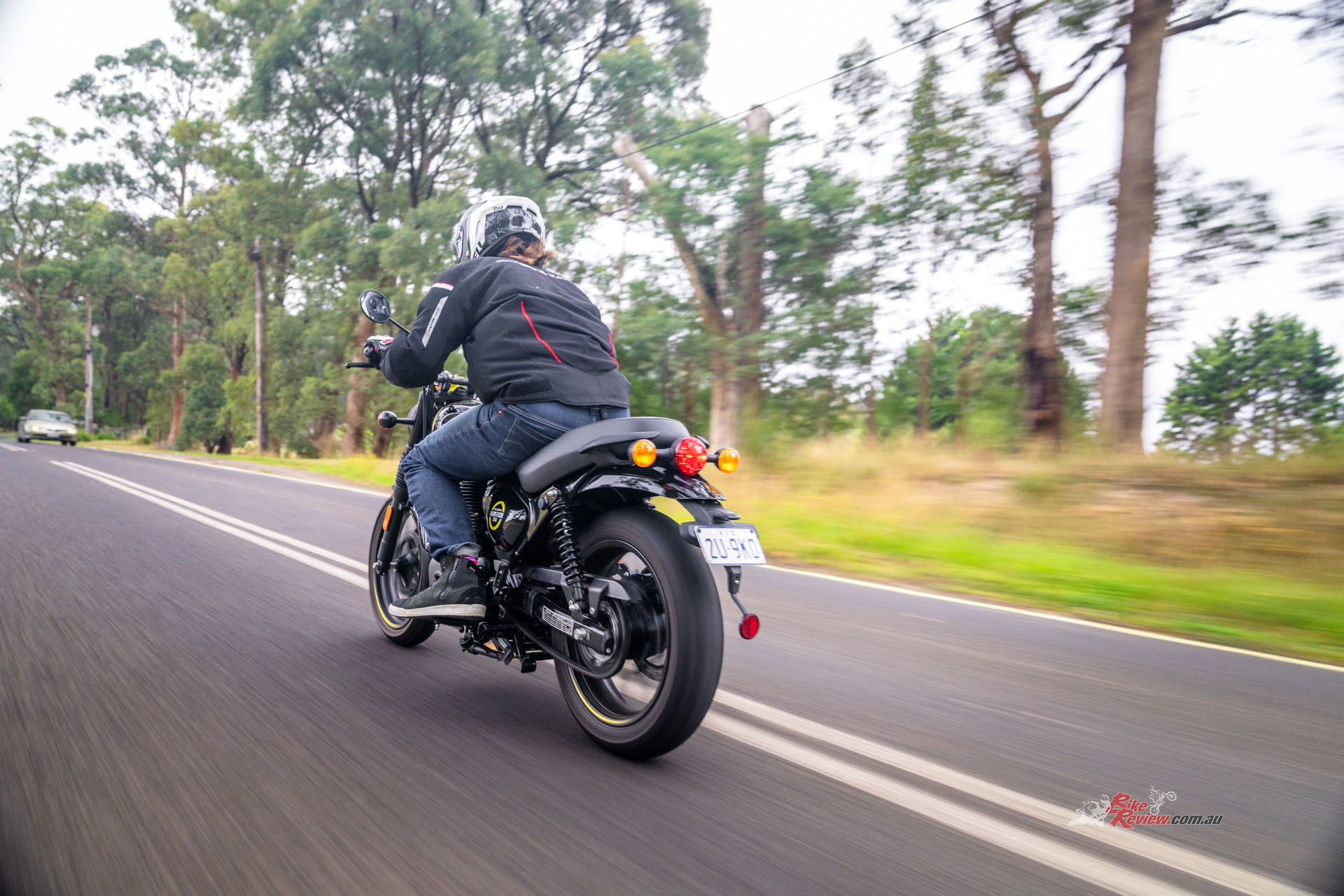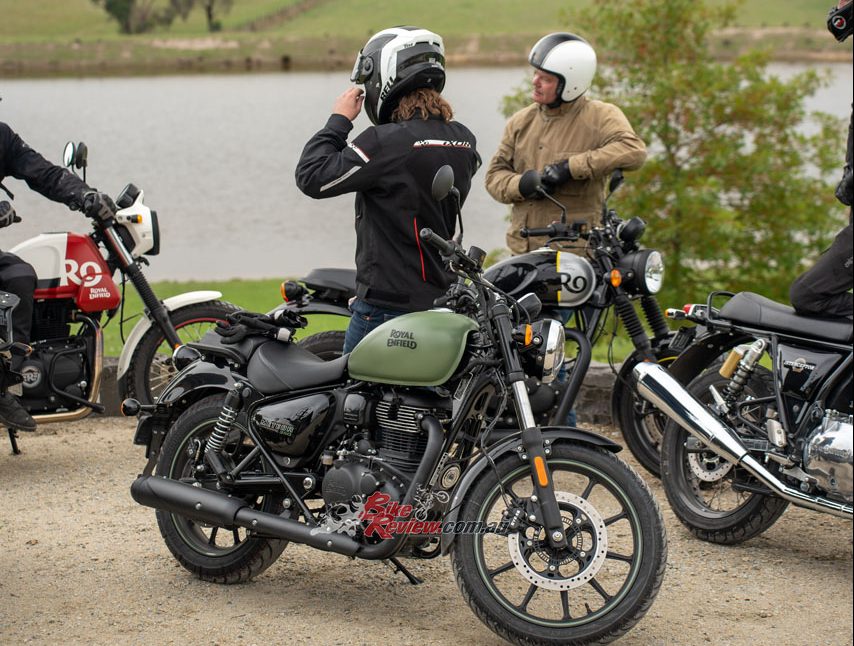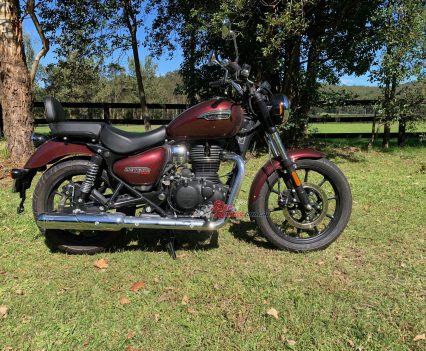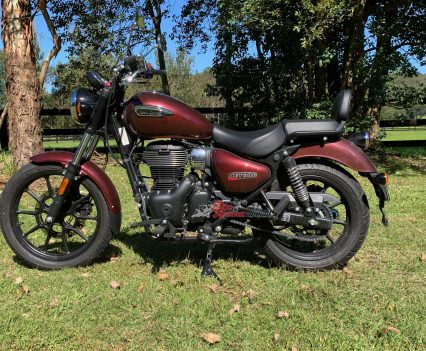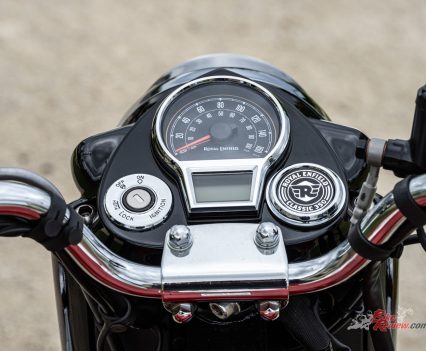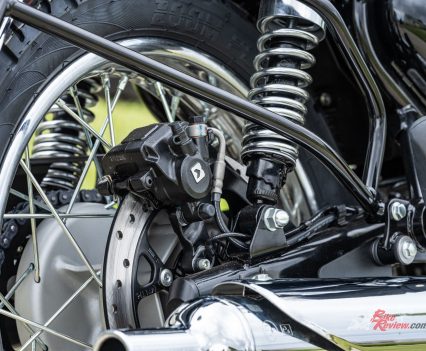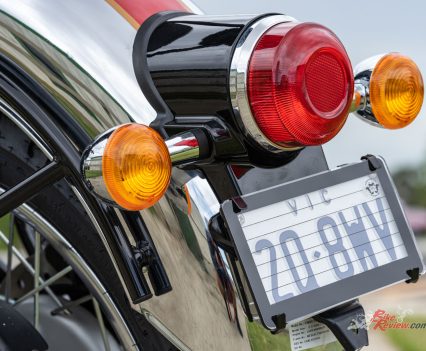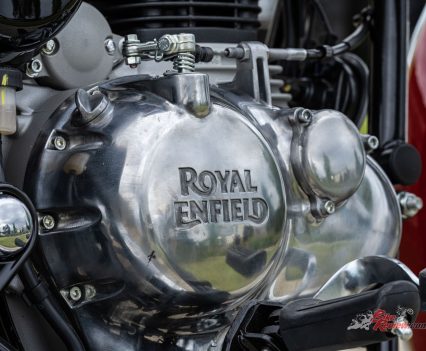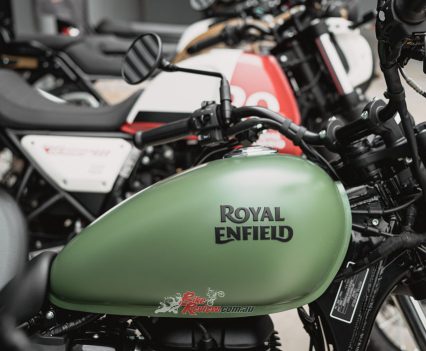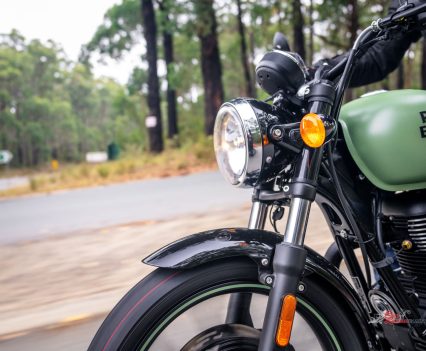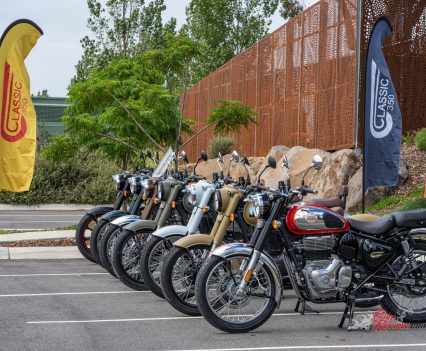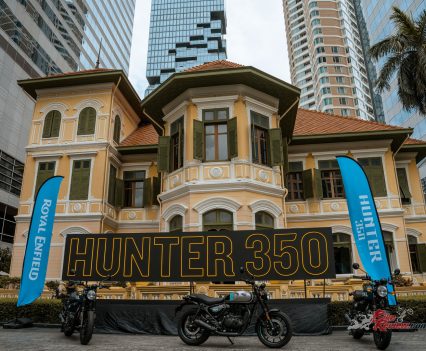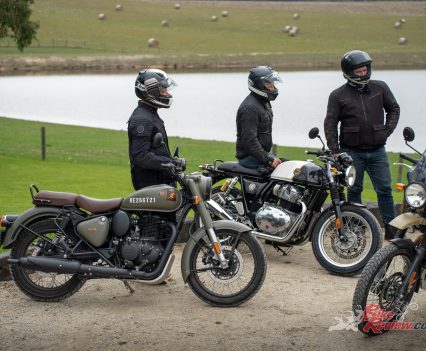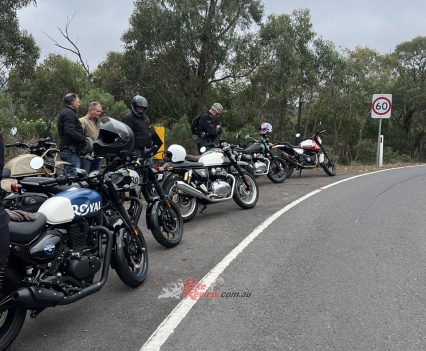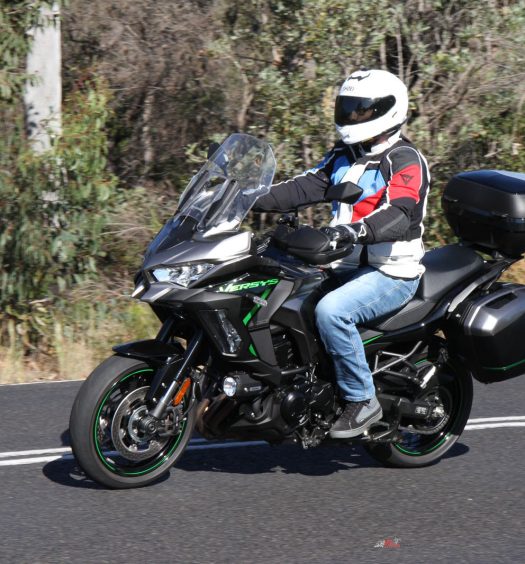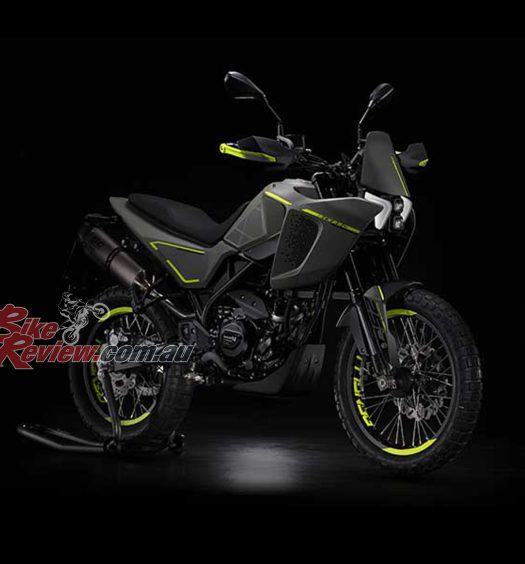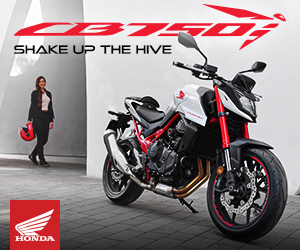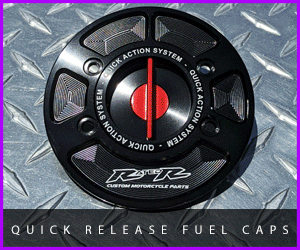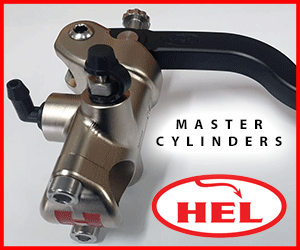Zane flew down to Melbourne to check out the entire 2023 Royal Enfield range. Read what he thought about the whole range and what his favourite machine was... Photos: Tom Fossati
There’s no better way to find your perfect fit than riding multiple machines on the same day. Royal Enfield threw a Ride The Range day where I found my perfect fit and enjoyed a wide range of bikes from cruiser to adventure. Check out my quick spins of the 2023 range…
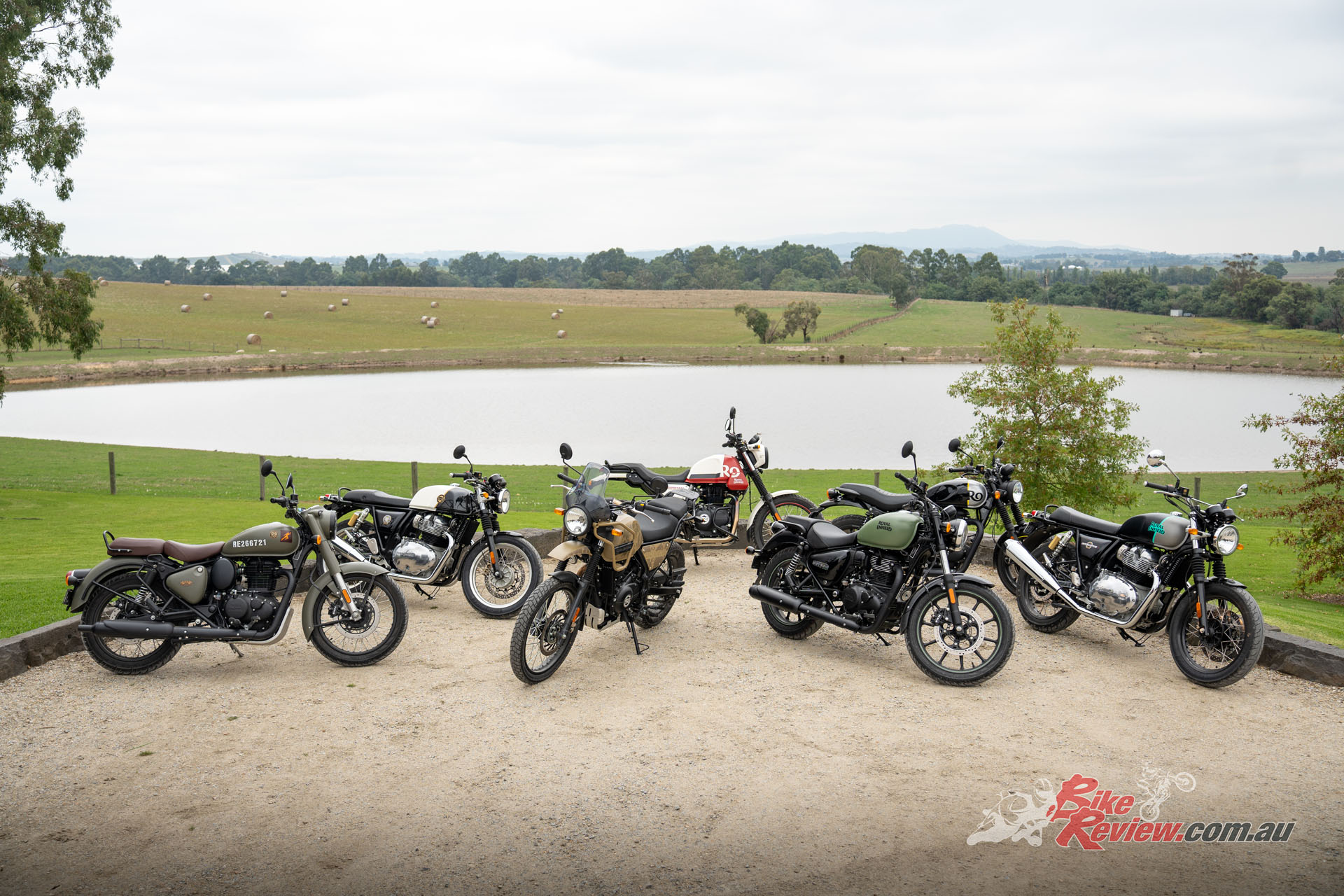
Royal Enfield threw a Ride The Range day for the Australian press, check out which bike Zane enjoyed the most!
I’d ridden most of the Royal Enfield range before heading down to Melbourne for a Ride The Range day that UMI organised for us, and if I hadn’t ridden a bike, I’d read about the model while editing the stories that go up on BikeReview.
Check out all of our Royal Enfield reviews here…
My experience with RE has been a long-path. I used to zip around on Dad’s Himalayan when I was 17/18, it was so much easier to ride than the Yamaha Renaissa I was entrusted with as my first bike. I remember thinking that a bike that looked old but had all the ease of a modern-day machine was the coolest thing ever, especially something that could tackle the Himalayas!
It’s no lie how popular Royal Enfield are with the new rider crowd. They do a great job of appealing to a range of people, mainly that demographic who haven’t grown up around bikes but get the sudden urge to explore this lifestyle. It comes back to that want for a classic bike without all the finicky reliability of an old bike.
When I tell people I’m a motorcycle journalist, if they’re not a rider a good 3/5 times the next thing out of their mouth is “Have you ridden many Royal Enfield’s? What do you think of them?”. I’ve had people I’ve gone to school with and who never showed interest in cars or bikes then, come up to me years later and be super excited to tell me they’ve bought a bike. What brand do you think it is? RE have broken into a market that others only wish they could tap into.
From then I’ve ridden 80 per cent of the range, most recently the Classic 350 at the Australian launch in 2022. What I hadn’t ridden was the 650 twins, the premium machine of the RE range and something I’ve always wanted to throw a leg over. Jeff has a bit of a love affair with his Interceptor 650, so I’ve always been eager to see what the fuss is all about.
Check out all of Jeff’s Interceptor 650 updates here…
UMI flew us down to Melbourne, staying the night in the hotel that Adina have built in the centre of the old HM Proson Pentridge, seriously such a cool spot to put a luxury hotel if not a little spooky! After a quick dinner and a few drinks while Mal mapped out our ride for the next day, I’m already looking forward to a simple and fun launch…
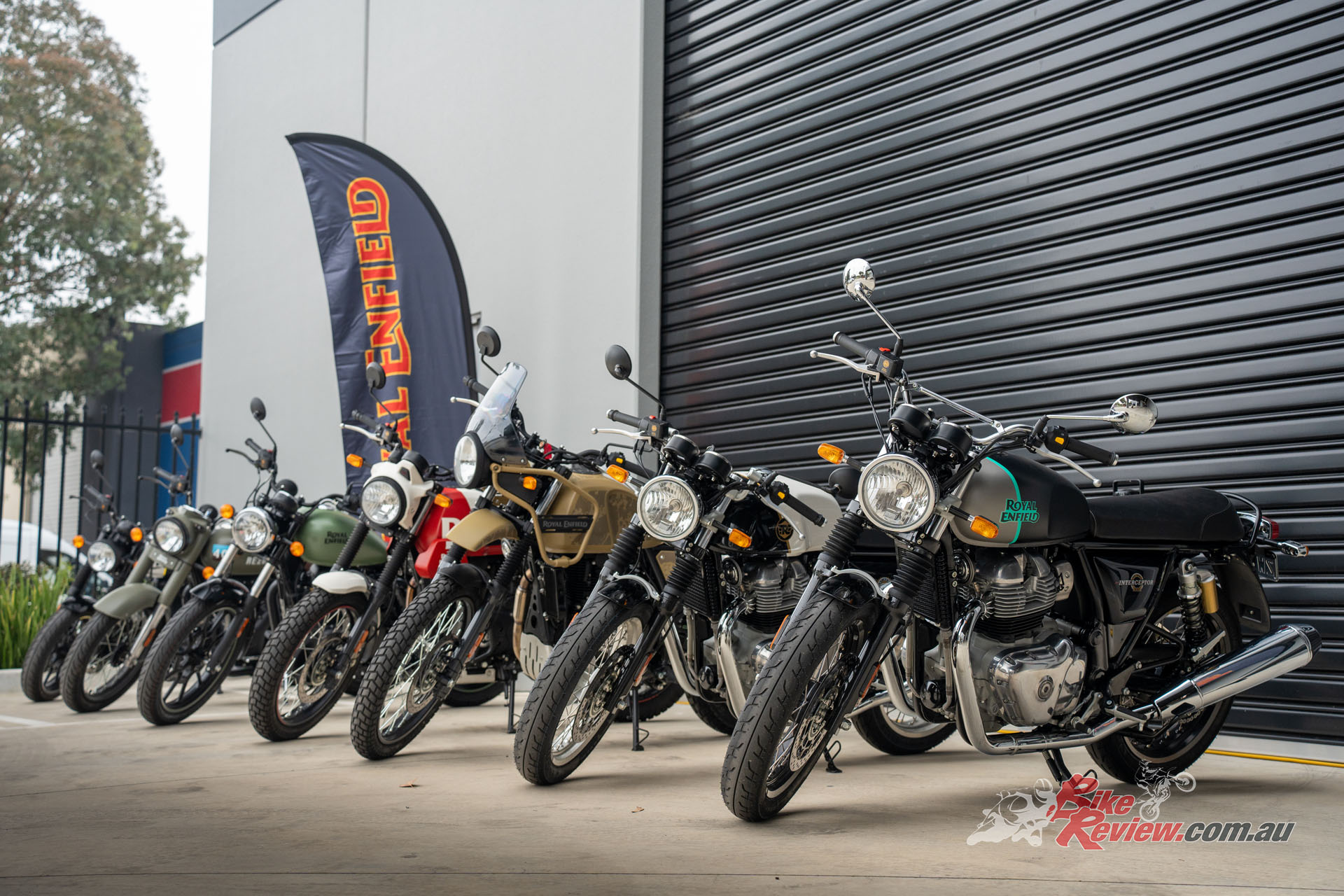
“For the price you pay across the board, it just makes sense to buy a Royal Enfield if you want to live your retro dreams on a budget.”
Heading into UMI and there’s a plethora of gorgeous bikes. For the price you pay across the board, it just makes sense to buy a Royal Enfield if you want to live your retro dreams on a budget. I have my eye on the 650 Twins first, but so did everyone else, I manage to hang my lid over the bars of the Continental GT 650 (my favourite of the pair).
Continental GT 650
My initial thoughts on the Continental GT 650 are “Damn this thing is small”, because it is! Royal Enfield have compacted that 650 twin-cylinder into a micro chassis, making it super accessible to a heap of riders. With that being said, I don’t actually feel cramped on it despite measuring up at 183cm, the rider triangle is angled in a way that you don’t need to worry about wacking your knees on the bars or getting back cramps. The Harris frame is a cracker.
The 650 Twin powerhouse is a lot more tame than I was initially expecting. The torque is extremely manageable and it’s so quiet with minimal vibrations that you don’t even notice when you’re hitting the rev limiter. 47hp@7250rpm isn’t hugely powerful but it’s more than enough to have fun on, if you were a new rider you’d have no problem wrangling the twin.
Check out our full length review on the Continental 650 GT here…
The 41mm conventional forks do a good job of soaking up the road and are definitely a good option given the budget. The Gabriel shocks look epic on the back, I’ve always had a soft spot for remote reservoirs that you can actually see. The rear does send some harsh bumps back up through your back and don’t do the best job of sorting out the harsh Australian roads, but the beauty of this is there’s plenty of options for setup.
The front brake works well considering it’s a single disc twin-piston caliper setup. I do think there are much better options for a bike of this size (mainly involving a disc on the other side of the wheel too), it’s a missed opportunity to make the Conti 650 a little more sporty. The rear brake has plenty of feel, allowing for heaps of slow-speed maneuverability, lane splitting is a dream with this setup! Saying that, they are Brembo brakes (By.Bre – By Brembo) so you are getting top quality and a second rotor would probably overwhelm the front tyre, so then a rim change would be needed which would ruin the styling.
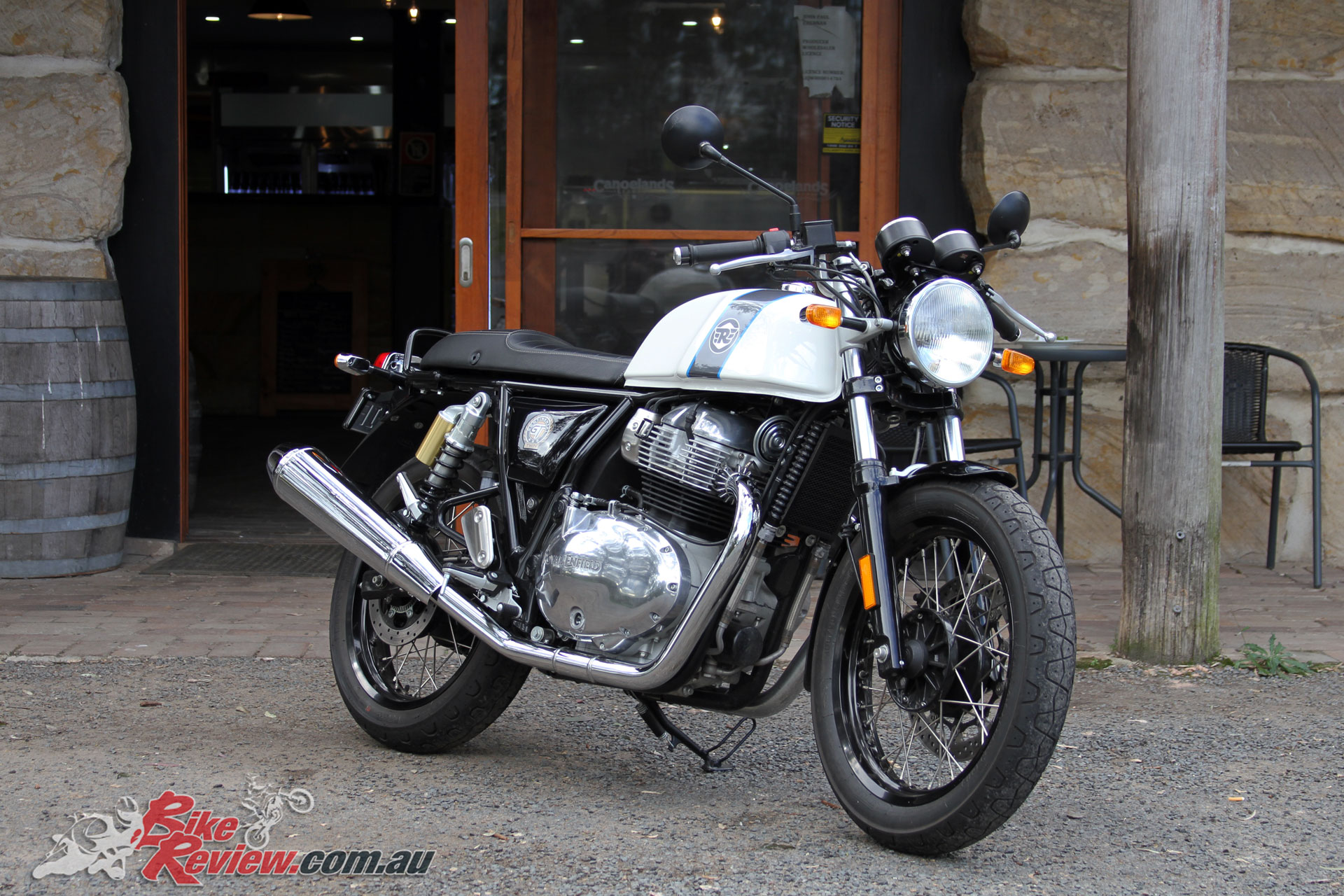
The suspension on the little 650 twin can be harsh at times but it’s more than capable enough to have some fun with.
Overall, it’s a super easy to ride bike with plenty of maneuverability through the corners and manageable power. I’d love to own one, give it a re-flash and start customizing it, it’s an awesome base for anyone who wants a reliable machine to start with.
Interceptor 650
Jumping on the Interceptor straight after the Continental GT 650, I’m expecting a similar feeling to the Continental that it shares all its key components with. However, I’m met with a completely different riding experience.
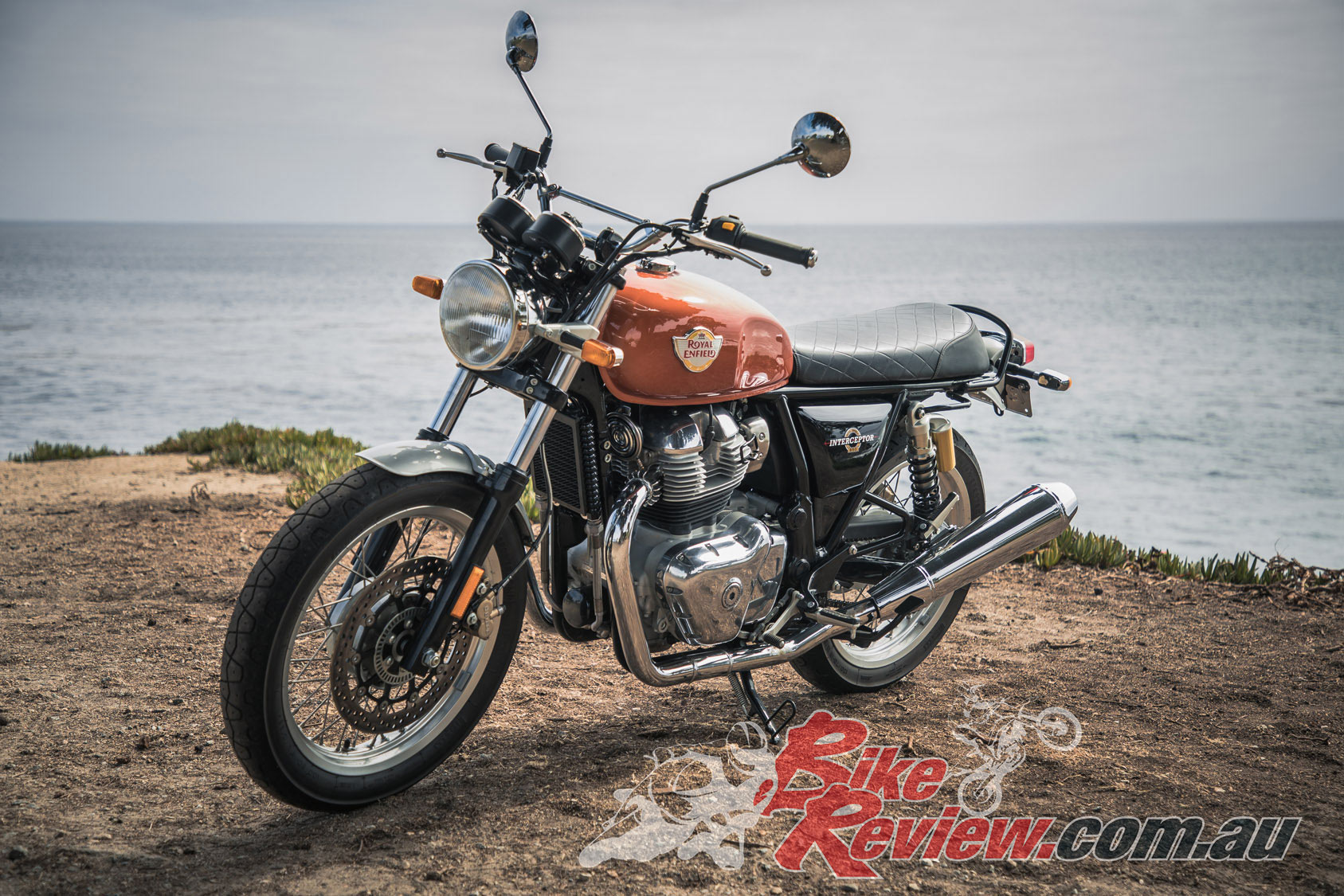
The Interceptor and Continental GT 650 share all of their major components but feel like two different machines.
The shift in rider triangle makes for an enjoyable cruiser, while a more upright seating position makes the Interceptor a little less taxing on the back and adds another level of slow-speed control. The less weight pressed on the front wheel compared to the Café racer style bars on the Continental makes for a noticeably lighter steering but slightly less front-end grip through the turns.
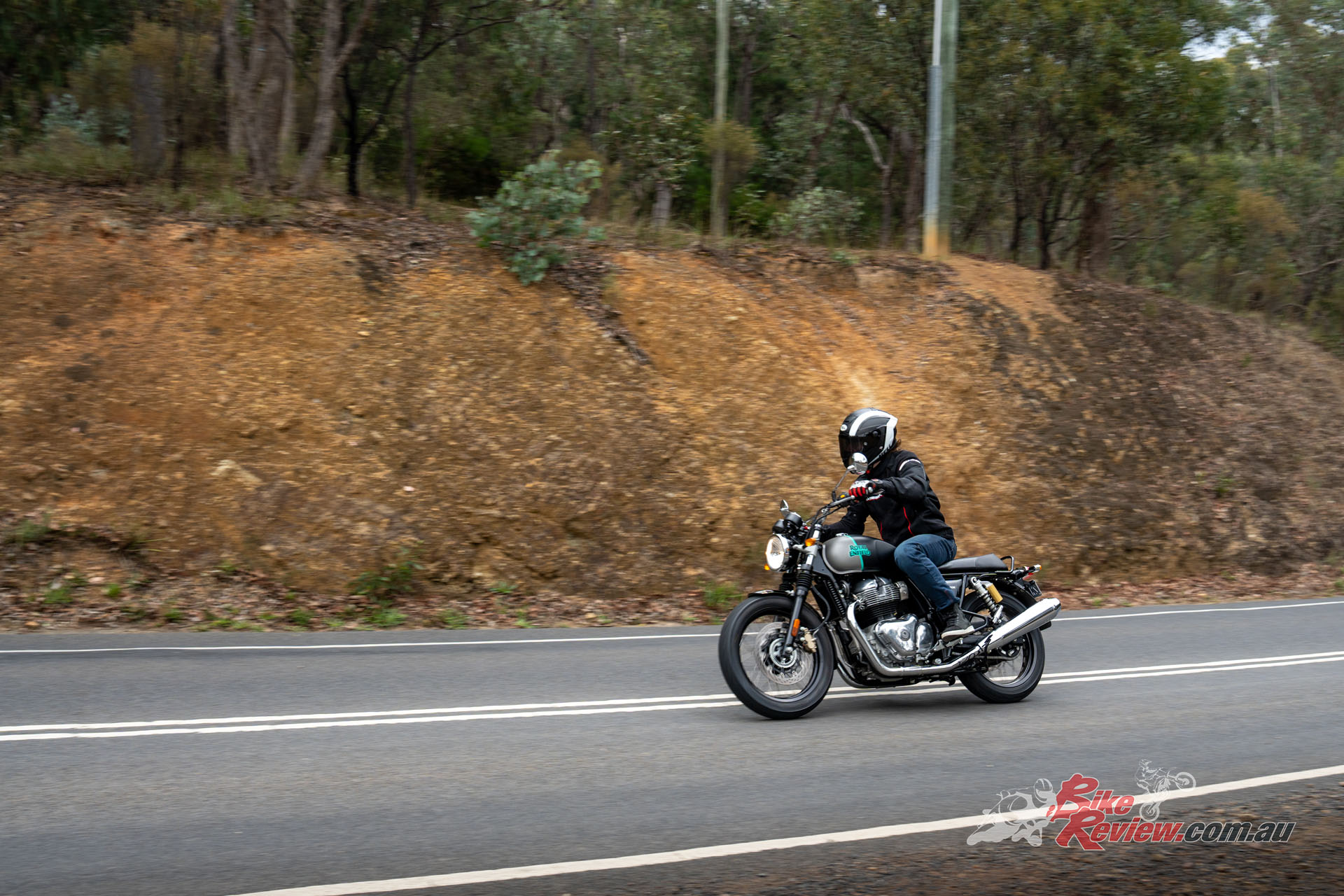
“The shift in rider triangle makes for an enjoyable cruiser, while a more upright seating position makes the Interceptor a little less taxing on the back and adds another level of slow-speed control.”
The forks and shocks are the same across both models, but the higher bars and less pressure placed on them due to the rider triangle means you don’t feel those firm front end settings as prominent. The rear feels almost identical, although the classic long seat seems to soak up the bumps better. The suspension being on the stiff side does allow for a more compliant and predictable chassis to have fun with through the twsities.
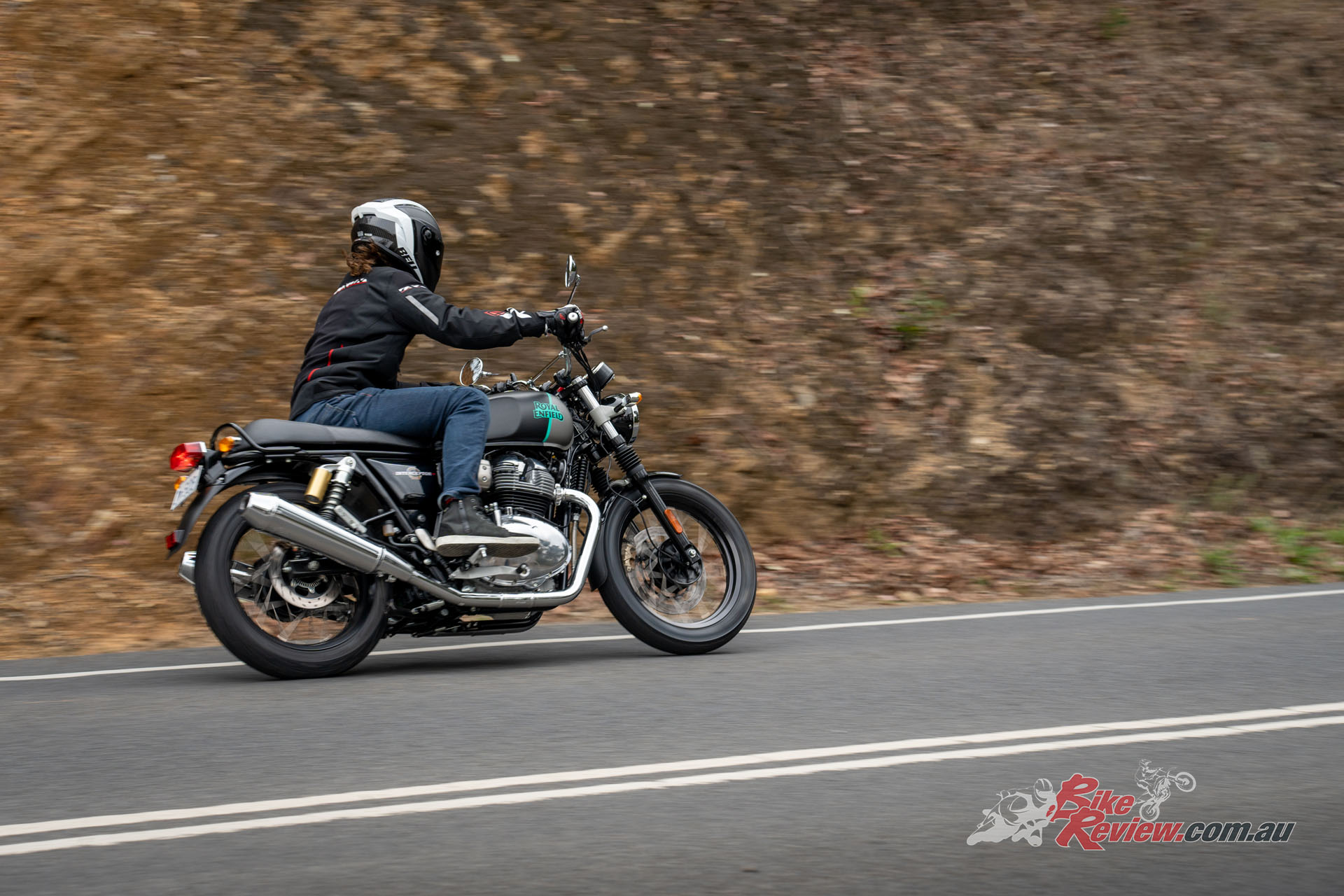
“The front forks and rear shocks are the same across both models, but the higher bars and less pressure placed on them due to the rider triangle means you don’t feel those firm front end settings as prominent.”
Check out our full length Interceptor 650 review here…
The gearing feels great on both bikes, the Interceptor and Conti sit on 110km/h without any complaints at all. The clutch action is nice and light, extremely new-rider friendly, the clutch action on the Interceptor does feel slightly easier just due to that ‘bar height. Probably cable routing.
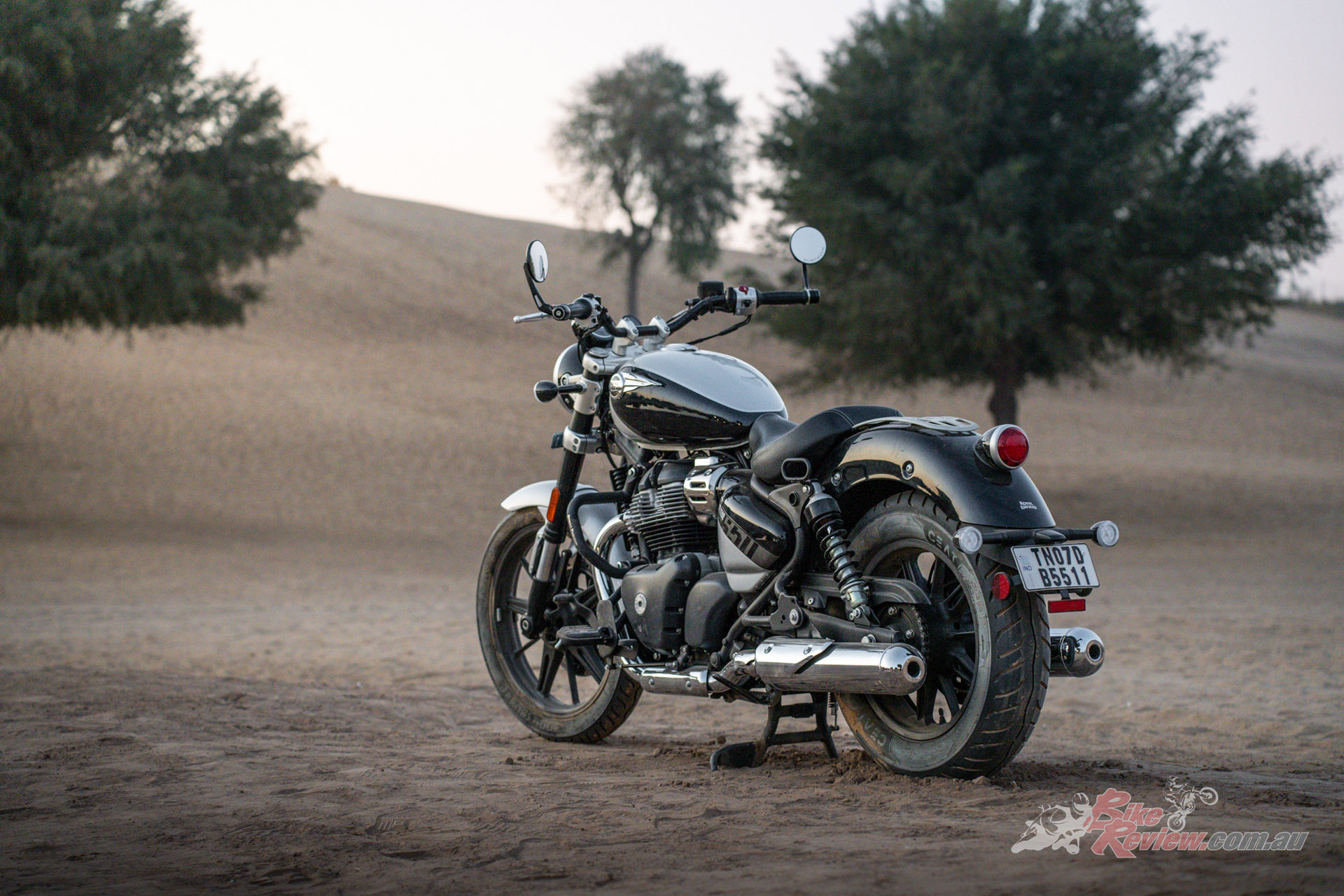
We didn’t get the chance to ride the all-new Super Meteor 650 as they haven’t actually landed in Australia yet! Head to the link below to check out our world launch test of it…
Super Meteor 650
We didn’t get the chance to ride the all-new Super Meteor 650 as they haven’t actually landed in Australia yet! Head to the link below to check out our world launch test of it…
Check out our Super Meteor 650 review here…
650 Twins Overall
Both bikes look and feel spectacular, the build quality far exceeds the pricetag. I can’t believe I’ve gone this long without riding either of them, they’re so-far my favourite of the RE range, but we have a long day ahead and plenty of bikes to ride.
This is one of the only bikes I’ve ridden where I believe an analogue cluster truly belongs. Not having a TFT screen in 2023 is something I feel is a big no-no, but the 650 twins would look silly with anything other than analogue dials. There’s one button and it’s super easy to use. A clock would be nice!
Both bikes feel like they weigh absolutely nothing, an interesting revelation for me as quite a bit of the RE range exceeds the typical weight of their category. While the Interceptor does weigh 4kg more than the GT it’s unnoticeable, what’s 4kg anyway? Like a big lunch and a beer or two.
If I had to choose between the two, it would be purely based on looks alone. The Interceptor is more comfortable due to those tall handlebars and upright rider triangle, but the GT has this seriously cool appeal to it. The GT does come in at an extra $300 ($11,290 rideaway) over the Interceptor ($10,990 rideaway) so it really is a personal preference choice between the two, both are awesome machines.
Himalayan
The Himalayan is a bike I am familiar with, as I said earlier my Dad owned one for a while. With that being said, I hadn’t ridden one for five or six years so I was eager to throw a leg over the 2023 model.
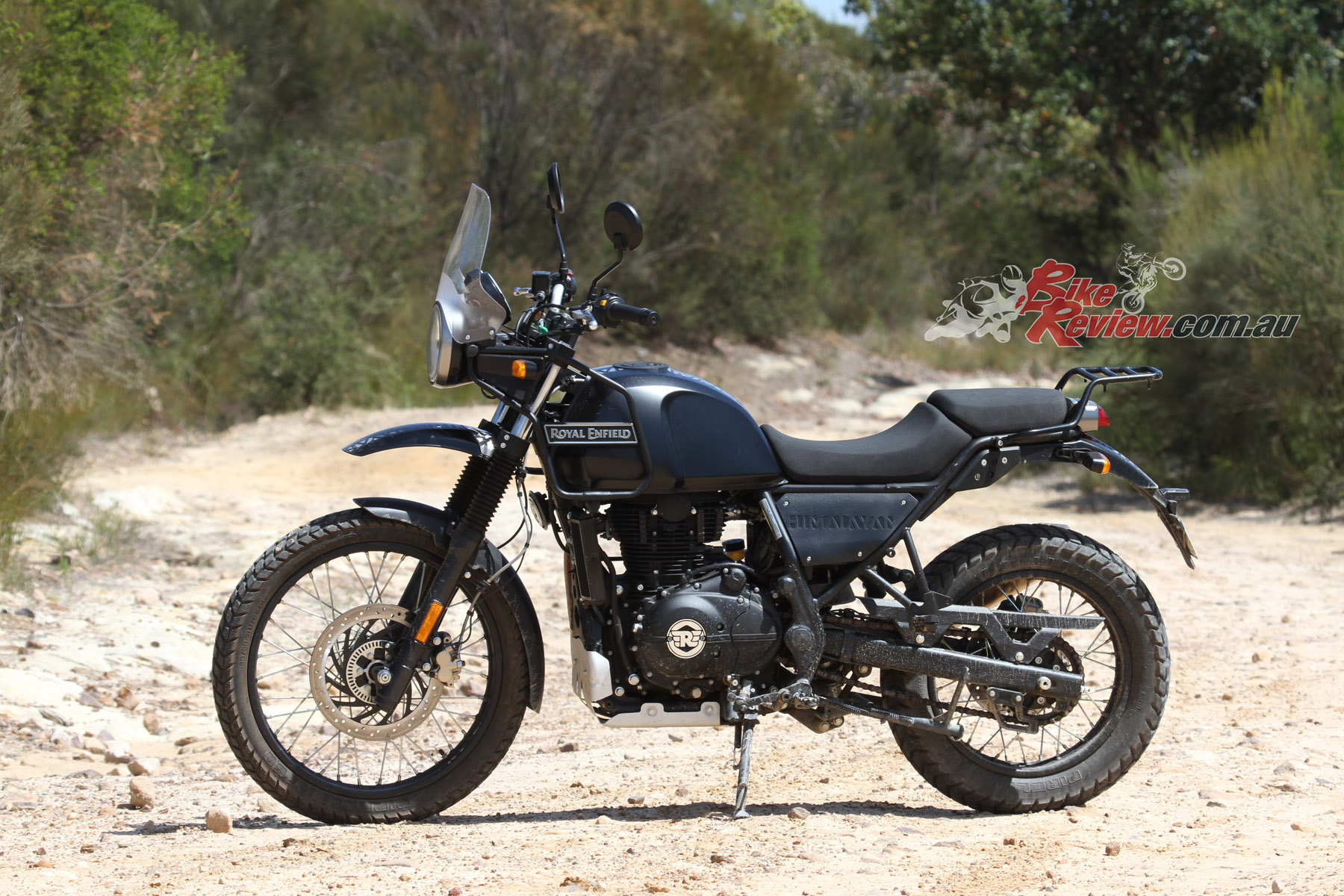
We are very familiar with the Himalayan here at BikeReview, they’re a seriously cool adventure bike…
Straight away you notice that plush suspension and comfortable seating position. The Himalayan feels like a bike you can pile the miles up on without any fuss, it’s also a sizeable machine despite its small engine size. And comfortable.
Check out our full Himalayan review here…
The dash has plenty of little goodies on it that proves its status as an adventure machine, a little compass is even built in! Everything is easily visible sitting down or standing up and the tall windshield does a great job of deflecting the wind away from a peaky helmet.
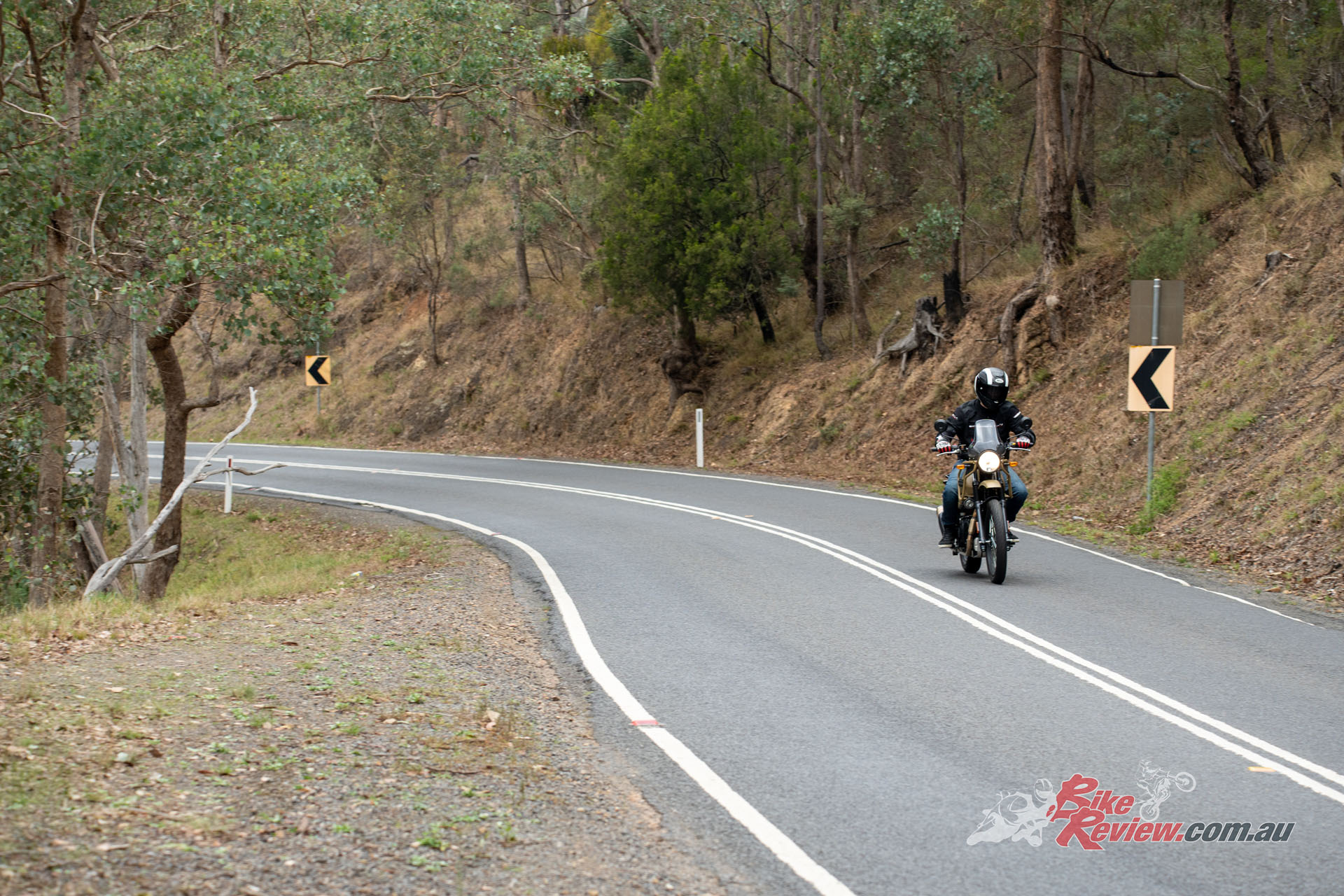
“The front, while soft, does a good job of tackling the turns, it’s no sportsbike but turn-in and lean are plenty stable.”
Kicking the stand up and you instantly realise that 24hp@6500rpm and 32Nm@4000rpm is as slow as it sounds on paper. But, you have to approach the bike from an angle that it’s clearly not made to go fast. 32Nm is enough to climb up some rough terrain and steep hills and the idea of a SOHC oil-cooled single is that it’s going to keep on pumping no matter how badly you treat it.
“The Himalayan feels like a bike you can pile the KM on without any fuss, it’s also a sizeable machine despite its small engine size…”
The front, while soft, does a good job of tackling the turns. It’s no sportsbike but turn-in and lean are plenty stable. At 180mm of travel, there’s plenty to play with if you desire to take the Himalayan off-road. I gave it a little go on a gravel side road, it tackles those roads with ease, no heavy vibrations.
The brakes are underwhelming. I’m really not fond of them by any stretch of the imagination. It may have just been the bike we had but there is little lever feeling and not much bite to them at all. Grabbing the front brakes after hopping off the 650 twins is like trying to stop a lathe with a bar of soap.
As I get used to the minimal braking power, I find myself enjoying the ride much more. Those CEAT hoops love to grip up on the road despite their knobby structure. It’s an enjoyable and comfortable ride, but those brakes need attention.
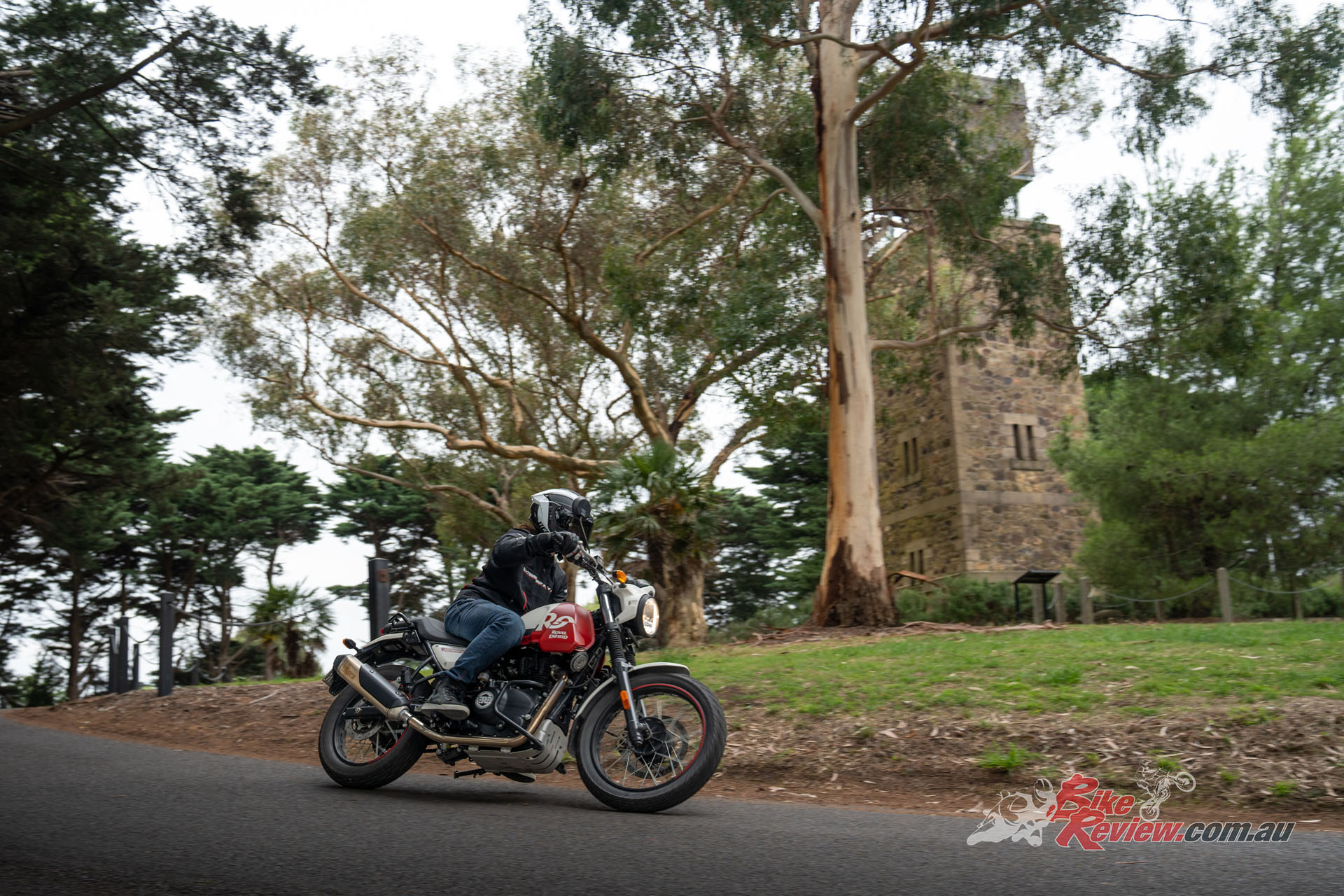
“Falling more into the Scrambler category, the Scram is a bucket of fun! I really didn’t expect to enjoy it this much.”
Scram 411
The Scram is a stripped back version of the Himalayan. It’s such a weird bike on paper, it loses a heap of bits that makes the Himalayan an adventure bike, like the crash bars, windshield, tall bars replaced with lower style ones and luggage rack.
Check out our launch review of the Scam 411 here…
Falling more into the Scrambler category, the Scram is a bucket of fun. I really didn’t expect to enjoy it this much. The powerhouse is still the same little 411cc SOHC powerhouse but loses a couple of KG over the Himalayan. The brakes on the Scram bite heaps better than the Himalayan, confirming my hypothesis that there was something off about the test machine.
The bar height slightly changes the rider triangle to a more dynamic road setup. It does change the overall feeling through the corners, there’s more intuitive steering feed back which means the Scram 411 absolutely loves tackling the corners!
There’s plenty of footpeg clearance so you can really get the Scram cranked over in the corners. A low-power motor means you can just pin it out of the turns with complete confidence that you’re not going to get your licence cut up, but still have heaps of fun.
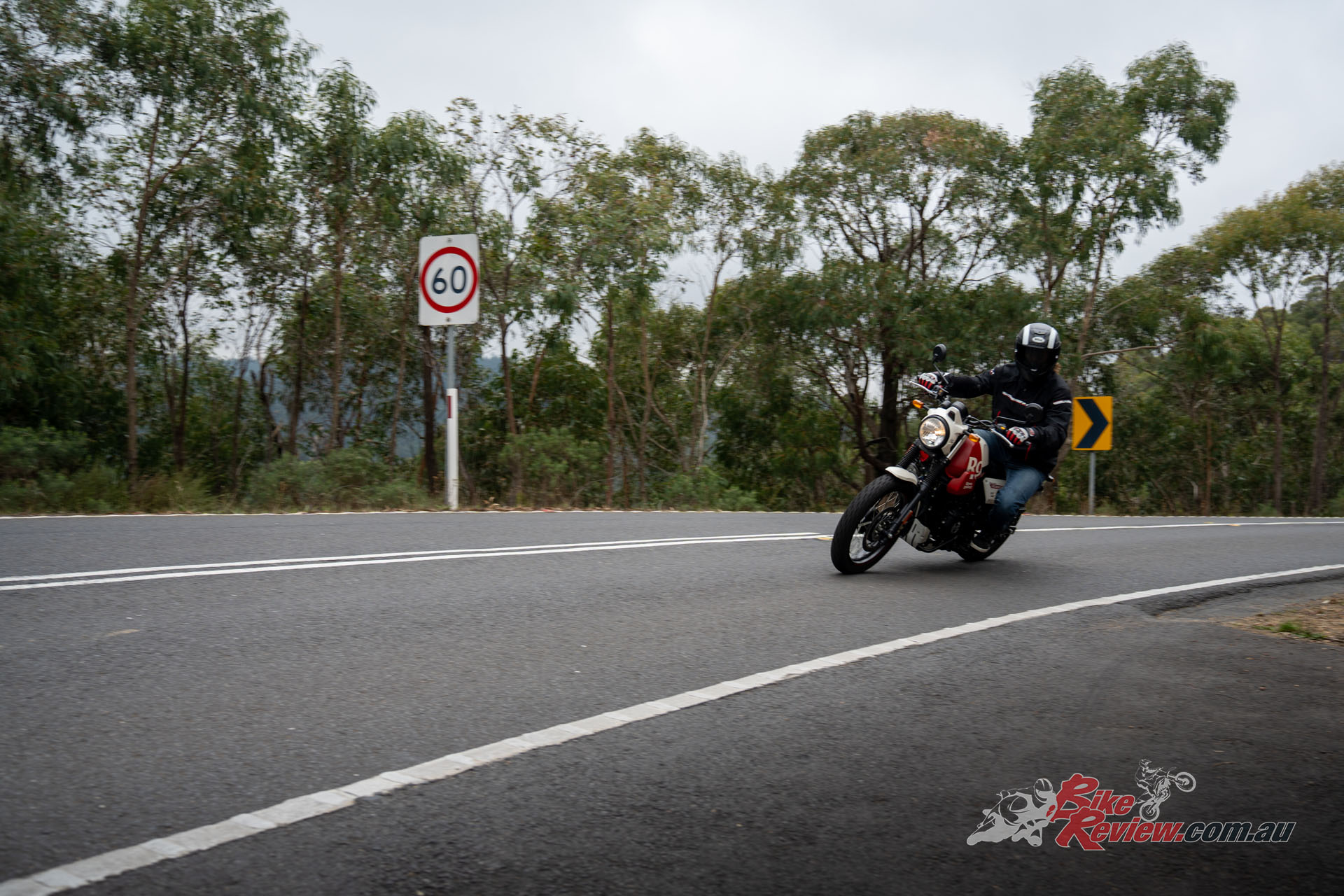
“There’s plenty of footpeg clearance so you can really get the Scram cranked over in the corners. A low-power motor means you can just pin it out of the turns with complete confidence that you’re not going to get your licence cut up.”
Not to mention that the Scram looks spectacular, Royal Enfield have done an amazing job of redesigning the Himalayan to look like a completely new model. The colours are all immaculate and the minimalistic design suits the chassis really well.
The Himalayan Models Overall
Between the two, I’d without a doubt go for the Scram 411. The way it rides and looks, while only slightly different to the standard Himalayan, does it for me. Both models ride really well and you can tell that basic EFI SOHC single-cylinder is just going to go forever.
The Scram comes in at $150 less ($8,240 rideaway) compared to the Himalayan ($8,390 rideaway). Under $9000 for a brand-new motorcycle is peanuts, the value is there and again, if you desire, you’ll have some change left over to modify things to your personal preference.
Hunter 350
The little Hunter 350 started my rotation of the growing J-Motor range from Royal-Enfield. I rode the Classic 350 at the Australian launch. But had not ridden the Hunter 350…
Check out our world launch review of the Hunter 350 here…
I felt like the appearance of the Classic 350 was one of the only things I really enjoyed about it. The Hunter 350 does away with the mid-century aesthetics so I’m fully expecting to really not have anything nice to say about, boy am I wrong.
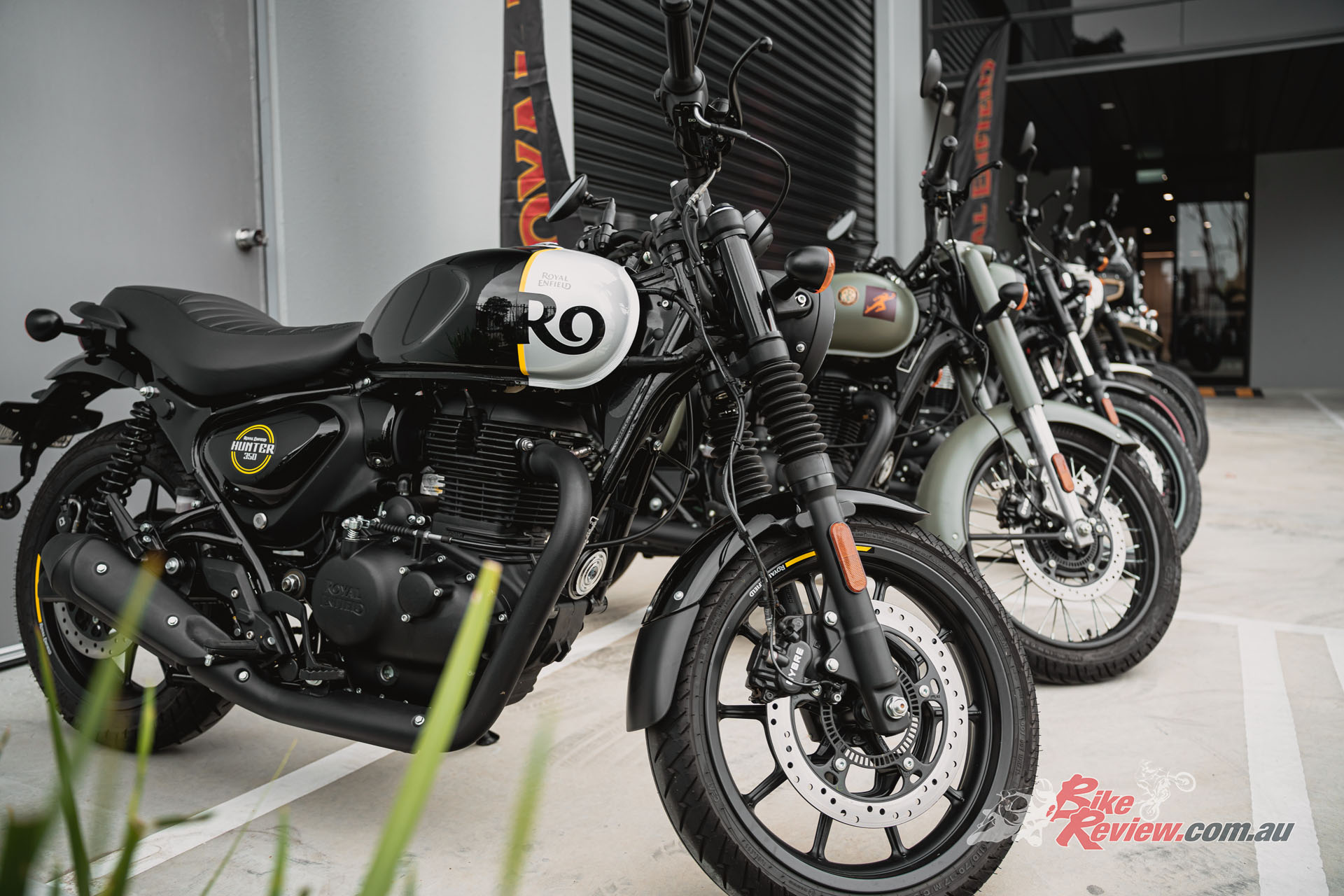
The Hunter 350 looks small for the outside, but the rider triangle is setup to accommodate all riders!
This bike is quite small from the outside, throw a leg over it and put your feet up on the pegs, suddenly it’s grown in size! The rider triangle is plenty roomy for my 183cm frame, the bars are the perfect height, and the pegs are in an awesome spot.
Out on the road and that little 349cc oil-cooled single is a bucket load of fun to just crank the throttle and hoon around on. If you take it at surface level that it only makes 20.2hp@6100rpm and 27Nm@4000rpm you’ll find yourself grinning as you keep the throttle pinned through the corners. The little 350 gives off the loudest and most aggressive exhaust note out of the entire RE range.
The rider triangle makes for a heap more enjoyable ride over the Classic 350 through the twisties. The slightly taller peg clearance means you can really lean it into the turns, combined with the almost flat bars, the turn in and mid corner feel makes for a tonne of fun.
The forks and shocks work well for what they are, don’t expect the most comfortable ride at this price point but you can expect predictable cornering and light steering. The short wheelbase promotes lightning-fast cornering and direction changes, it’s honestly like riding a minibike with big wheels to help overall grip and performance.
The brakes work well, not that you’ll need to use them much with this little bike. A twin piston caliper grips the front 300mm disc, while a single piston caliper grips a 270mm. The rear brake allows for plenty of feel while you get used to riding at low speeds.
“The Hunter 350 is one of the easiest bikes I’ve ever ridden, someone who has never thrown a leg over a bike before will have absolutely zero issues getting to grips with it.”
The Hunter 350 is one of the easiest bikes I’ve ever ridden, someone who has never thrown a leg over a bike before will have absolutely zero issues getting to grips with it. “The perfect beginner bike” is an understatement. I had no idea I’d love this thing as much as I do, the Hunter definitely produced the biggest smile of the whole range for me.
Meteor 350
The Meteor 350 is almost the polar-opposite of the Hunter. A more cruiser-inspired ride, it features all the same components as the Hunter but adopts a large front wheel and completely different rider triangle to make it a cruiser.
Read our full Meteor 350 review here…
The little Meteor 350 is plenty comfortable, the cruiser position suits the 350 perfectly for a run-around machine. Run-around being the keyword as the gearing isn’t particularly fond of doing freeway speeds, you may have a little struggle to keep it at 110km/h going up steep hills.
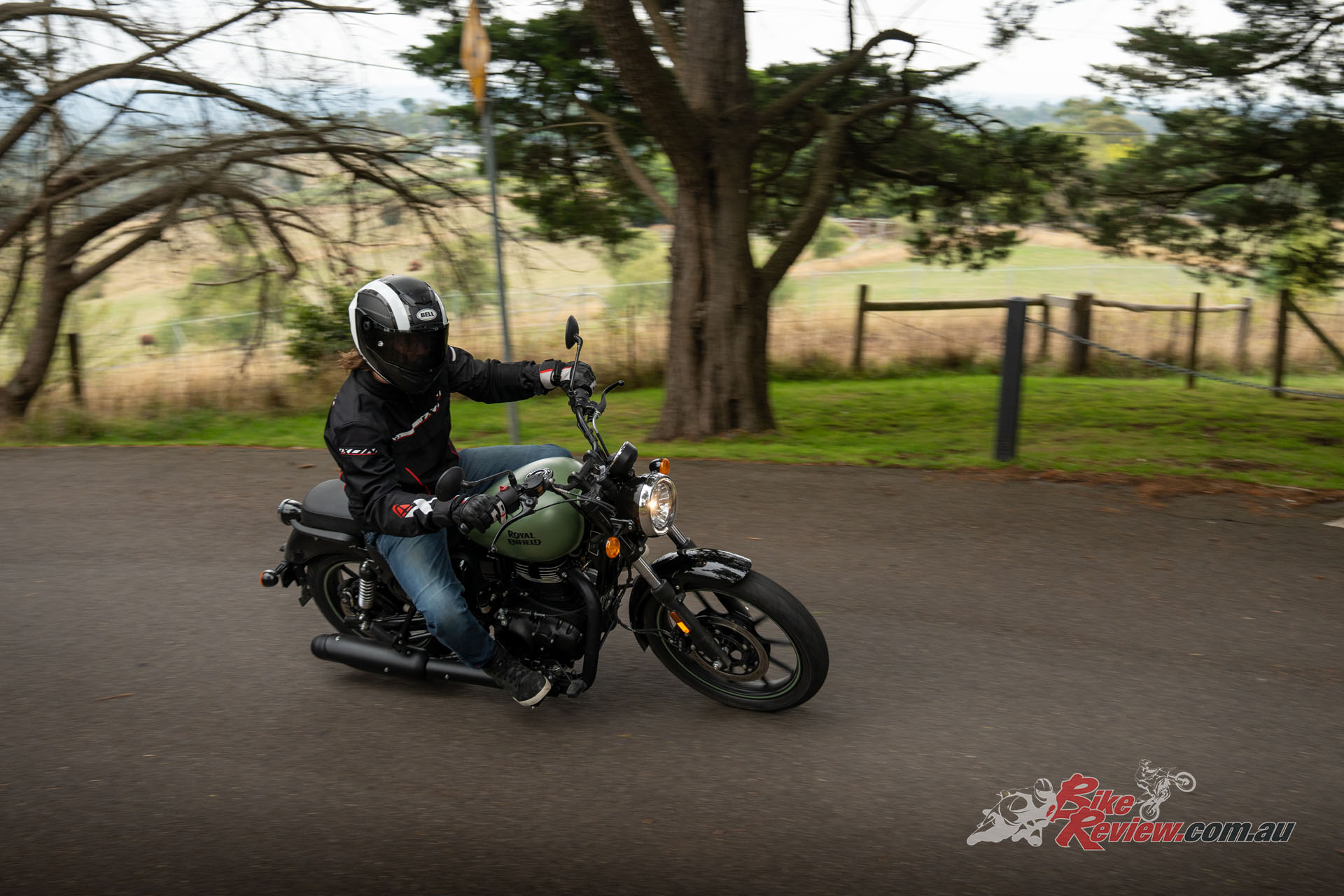
All of the 350 model will do 110km/h but might struggle to go up hills on the freeway unless you click it down a gear…
It’s honestly like riding a lounge, it feels much bigger on the bike than it appears from the outside. Again, tall people will have no issues feeling roomy on this little machine, there’s plenty of reach to the ‘bars and while you haven’t got as much space as something like a Harley, you’ll have no issues churning out the KM on it.
The heel-toe shifter takes a little bit of getting used to, especially if you have big feet like me, you’ll click it up a gear with your heel a handful of times while you learn to get used to it. Another issue with the footpegs is the position when sitting on the bike and pushing it around, they’re in a slightly awkward position which catches your shins.
It’s not the most exciting bike nor the best looking one, but it’s still easy to ride. It’s yet another awesome beginner bike for someone who just wants to cruise around on but wants something with a bit more street cred than an automatic scooter.
Classic 350
I only took the Classic 350 for a very short spin, having spent plenty of time on it at the Australian launch. It’s still the same cool looking little machine with an easy to manage engine and swift manoeuvrability. Revisiting the model made me enjoy it a little more than I initially did.
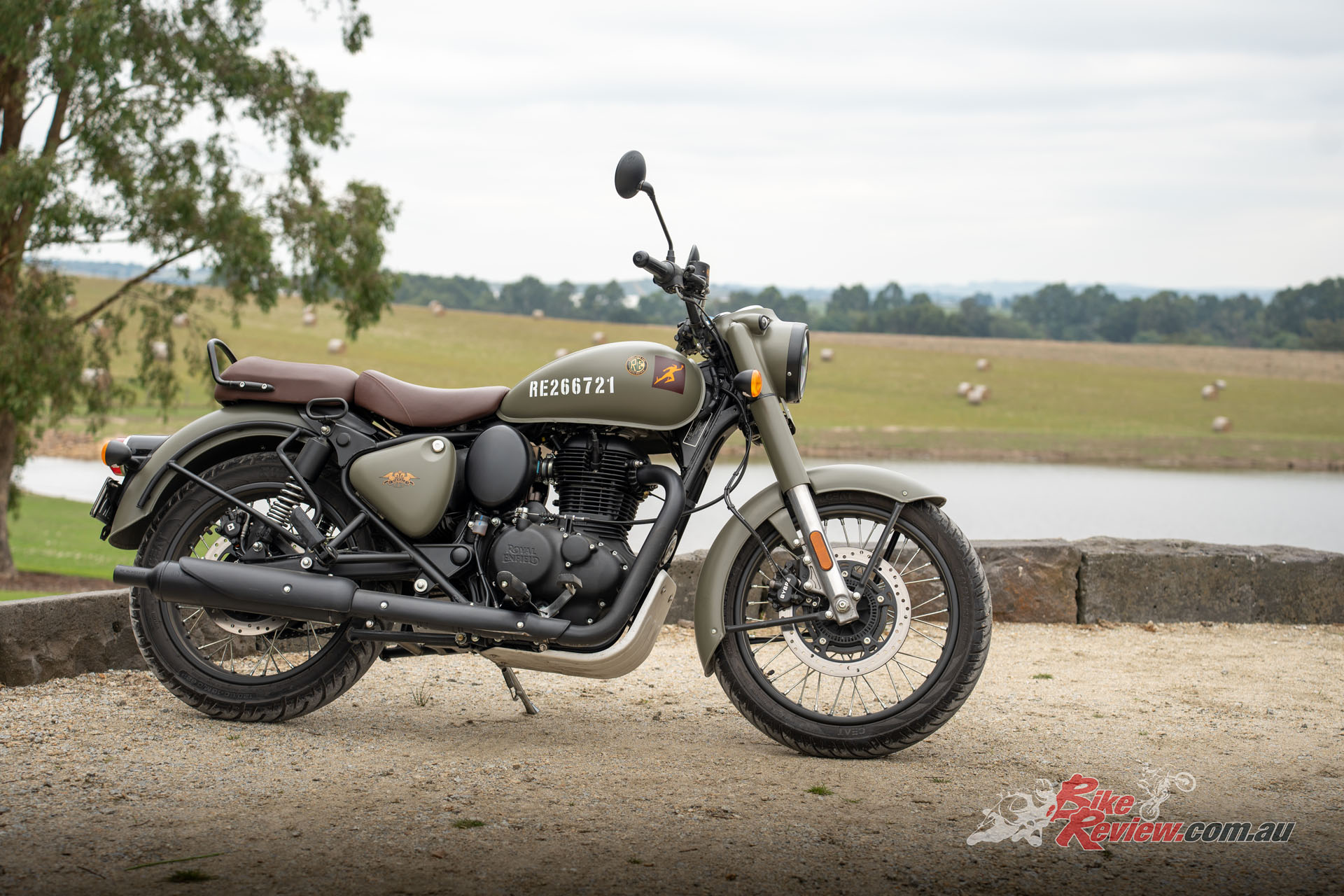
While I initially wasn’t too fond of the Classic 350, I’ve learnt to appreciate it revisiting it with a fresh outlook.
If you want my full thoughts on the Classic 350, check out my review below but the bottom line is I’ve learnt to appreciate its appearance a little more. Royal Enfield have done a spectacular job of styling this little machine, it looks like a scaled down full-sized bike but encapsulates the era important styling queues of the ‘50s.
Check out our Classic 350 review here…
The Classic 350’s footpeg position sits in-between that of the Hunter and the Meteor, which makes the little bike feel cramped if you’re around my height. The footpegs see the same fate as the Meteor, they’re in an awkward spot when pushing the bike around while sitting on it.
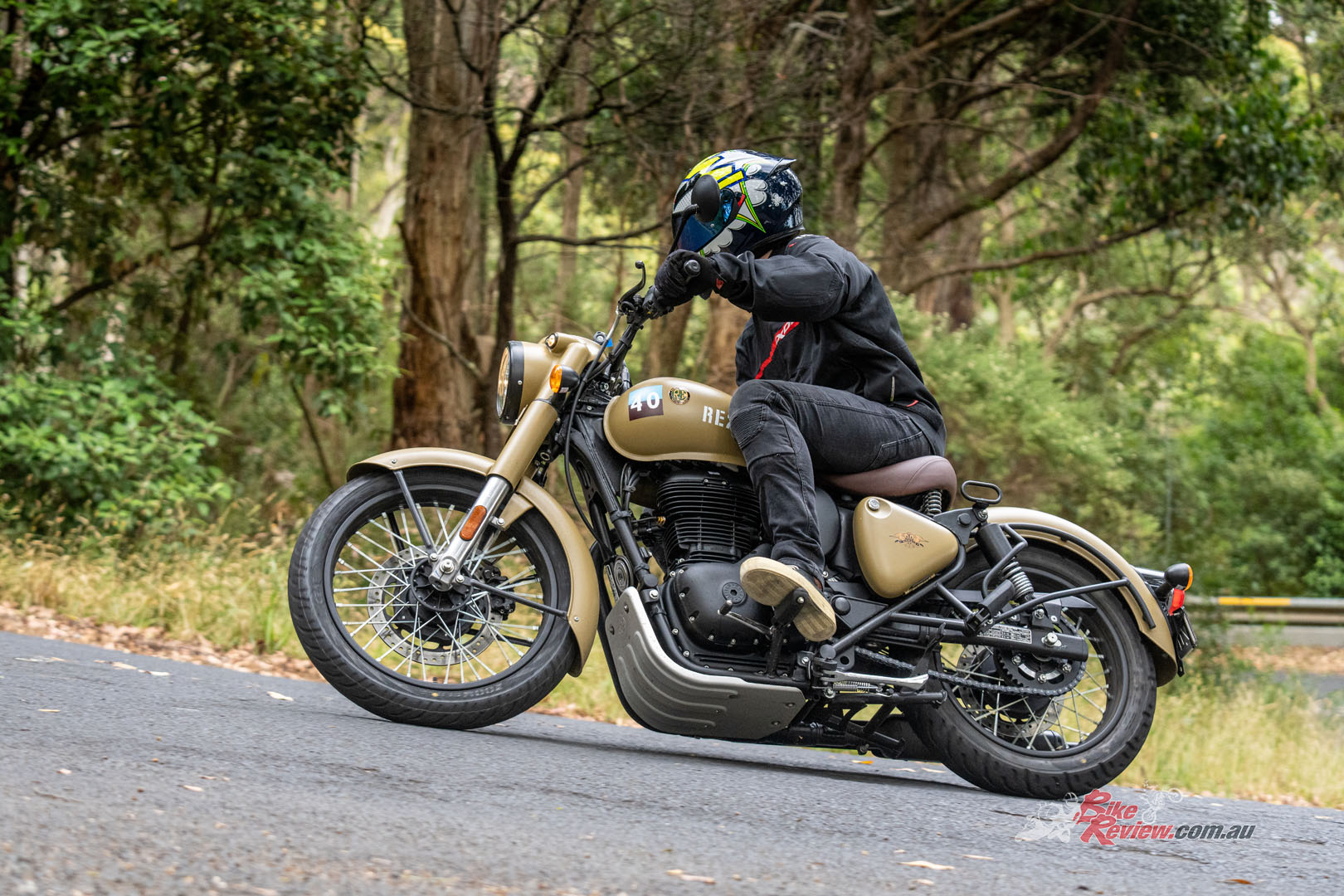
Slow and tight turns are easy on the Classic 350, you shouldn’t have any issues tackling the M.O.S.T course on it!
Despite a semi-cramped leg-position, the Classic 350 is a comfortable bike. The big, wide seat helps soak up any bumps those twin shocks might miss, while the front feels a little different compared to the Hunter, most likely due to the 14kg it has put on over it.
It’s not the most fun or exciting bike to ride, but it has so much character and honestly looks the part. Despite having more fun on the Hunter, the looks alone make me consider the Classic 350 as a bike I’d love to own.
350 Range Overall
All three of the 350 machines are some of the easiest to ride bikes I’ve ever thrown a leg over. Extremely simple with an analogue dials across all three (and a small LCD on the Hunter) make for little confusion for new riders.
The five-speed gearbox has extremely forgiving gearing should you choose the wrong gear at the lights or forget to shift down into a corner. The clutch actions are extremely light and have a really long friction point, making it difficult to stall if you’re not used to a motorcycle clutch.
“All three of the Royal Enfield 350 machines are some of the easiest to ride bikes I’ve ever thrown a leg over…”
Yes, they are so slow, but that’s not the point. They’re the perfect new rider companion, they look the part and they don’t have that “old-bike reliability”, which is a perfect option for those who aren’t mechanically minded.
Starting at $7,590 rideaway for the Hunter 350 and $7,590 for the Classic and Meteor 350 (price goes up depending on what colour scheme you’re after) it’s peanuts for a cool looking bike that’s so incredibly easy to ride.
The 2023 Range Final Verdict
Royal Enfield continue to impress me as their range expands yearly. This ride made it clear that no matter what RE you choose, you’re going to get an easy to ride, reliable and, most importantly, a cool looking bike for next to nothing.
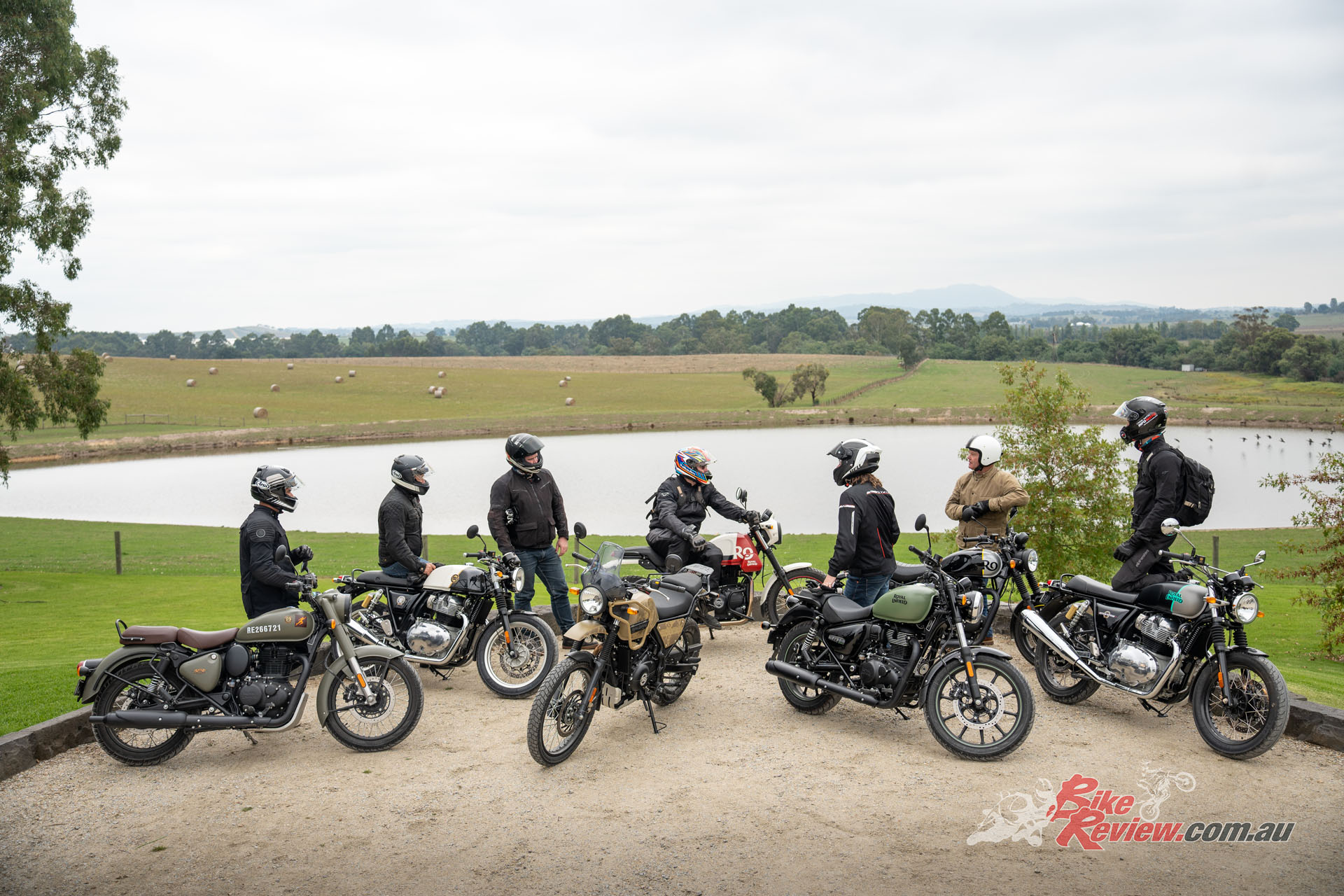
“This ride made it clear that no matter what RE you choose, you’re going to get an easy to ride, reliable and, most importantly, a cool looking bike for next to nothing.”
All of the machines are really well priced for what they are and all of them have heaps of character. Not to mention that UMI continue to bring in a huge amount of colour and accessory options, you’ll have no problems making your ride uniquely yours.
Check out all of Royal Enfield’s accessories here…
Each bike I rode, I had a vision about how I would modify it and how I’d make it my own, they’re such a popular brand that you won’t have trouble finding parts, genuine or aftermarket.
The all important verdict, what would I buy? Look, the Continental GT was the bike I thought I’d choose and I’d still love to own a GT one day but it didn’t take the cake for the range. The bike I actually enjoyed riding the most was the Hunter 350, weird right? I’m a bit shocked myself.
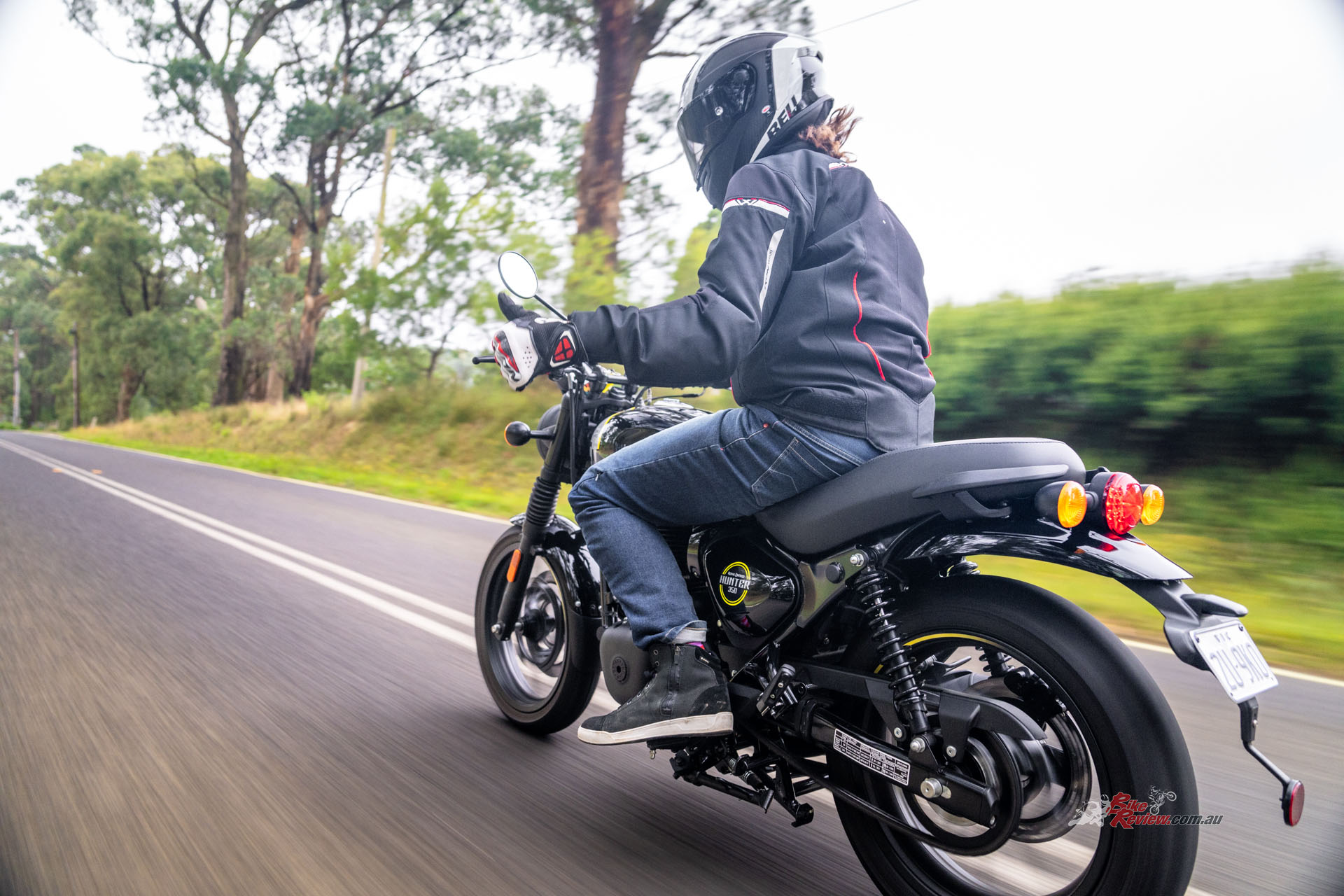
The Hunter 350 gets a tick of approval from Zane, only just trumping the 650 twins as his favourite of the 2023 range…
There’s just something about how it rides and handles that really did something for me. I think it’s because it reminded me of my first bike and I daydreamed of all the silly modifications I’d love to do to it. It’s stupid easy to ride, cheap and so much fun to thrash. It would be so funny to make one of these into a sporty little racer…
Editor’s Note: If you are reading this article on any website other than BikeReview.com.au, please report it to BikeReview via our contact page, as it has been stolen or re-published without authority.


